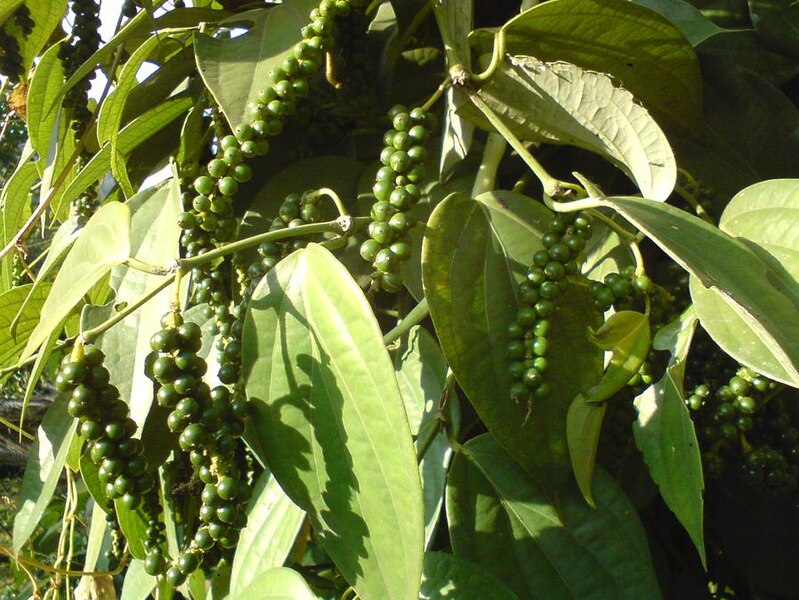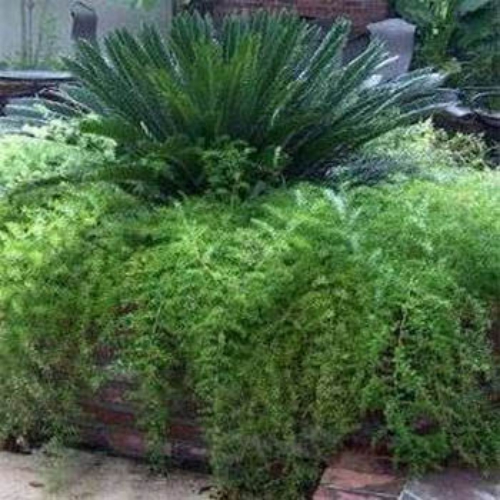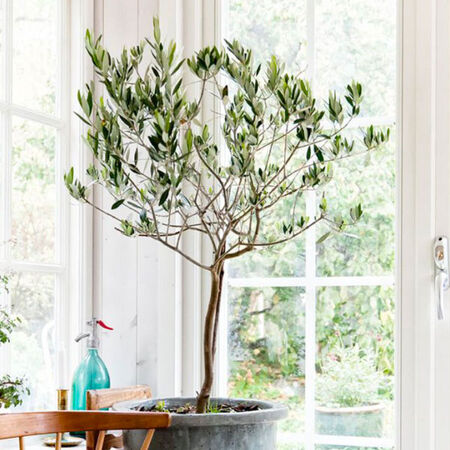New Account | Seed Mix |
Gift Certificates |AAS Winners |
Gardening Products
SEEDS: Unusual | Annuals | Perennials | Vegetables | Herbs | Trees
Unusual Houseplant Seeds from around the World
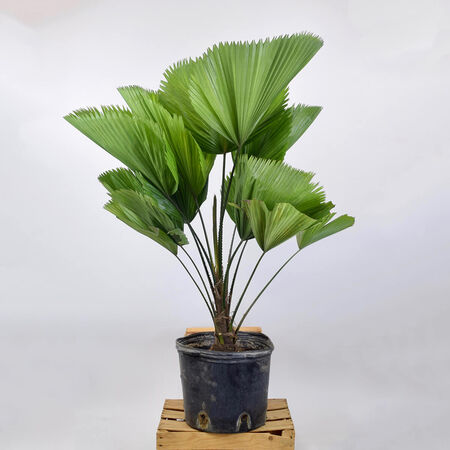
JB264 Ruffled Fan Palm ( Licuala grandis )
Produces a beautiful tropical palm plant that is most commonly found grown as houseplants. This green palm is not only beautiful but also helps clean the air indoors. Botanical name is Licuala grandis but more commonly known as Ruffled fan palm.
This elegant palm is great for small yards and can also grow indoors in containers in cooler climates, makes a wonderful patio plant. This is a very attractive, slow growing palm that can get up to 6-8 feet tall outdoors in warm climates, with a spread of 4 feet wide. It has a single slender trunk, 4-5 inches in diameter that takes years to develop.
The Ruffled Fan Palm is known for its unique palmate, or fan-shape leaves, with attractive splitting patterns that make it stand out in any environment. Leaves are circular, luscious green, glossy, ruffled, hence the name Ruffled Fan Palm, about 22 inches in diameter, with notched tips.
It grows best in partial shade and should not be exposed to full sun. Also, make sure to protect it from high winds to avoid frond damage. It needs a lot of water with good drainage. It can tolerate cold down to 30F when mature.
Seed Germination: These seeds inherently have a low germination rate, expect 30-40 percent in most cases.
This elegant palm is great for small yards and can also grow indoors in containers in cooler climates, makes a wonderful patio plant. This is a very attractive, slow growing palm that can get up to 6-8 feet tall outdoors in warm climates, with a spread of 4 feet wide. It has a single slender trunk, 4-5 inches in diameter that takes years to develop.
The Ruffled Fan Palm is known for its unique palmate, or fan-shape leaves, with attractive splitting patterns that make it stand out in any environment. Leaves are circular, luscious green, glossy, ruffled, hence the name Ruffled Fan Palm, about 22 inches in diameter, with notched tips.
It grows best in partial shade and should not be exposed to full sun. Also, make sure to protect it from high winds to avoid frond damage. It needs a lot of water with good drainage. It can tolerate cold down to 30F when mature.
Seed Germination: These seeds inherently have a low germination rate, expect 30-40 percent in most cases.
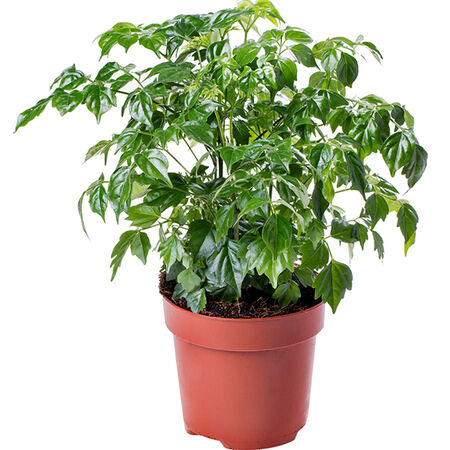
D5137 Radermachera ( China Doll )
A perfect houseplant. It tolerates the dry air of central heat well, and does not require direct sunlight. A decorative shrub with large compound leaves. Takes little time to raise from seed.
It makes great impact with lots of attractive, fresh green leaves, that stay glossy even in the dry air of heated homes. great for air purification indoors.
It makes great impact with lots of attractive, fresh green leaves, that stay glossy even in the dry air of heated homes. great for air purification indoors.
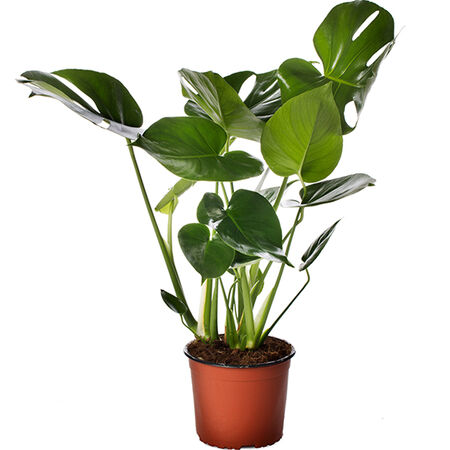
TRZ139 Tauerii Monstera
This is a more dwarf version of Monstera that is better suited for use as a houseplant. Tauerii is a stunning, tropical foliage plant, with large, heart-shaped leaves with lots of perforations. Tauerii is a dwarf-type Monstera and particularly develops its leaf perforations early. This plant tends to set earlier than other Monsteras. Monstera deliciosa Tauerii is well-suited as a decorative houseplant. Monstera deliciosa Tauerii is commonly known as Swiss cheese plant. Prefers full to partial sun.
Seed Germination: Plant at least 2-3 seeds per pot. Bottom heat is helpful. Takes 14-28 days to germinate.
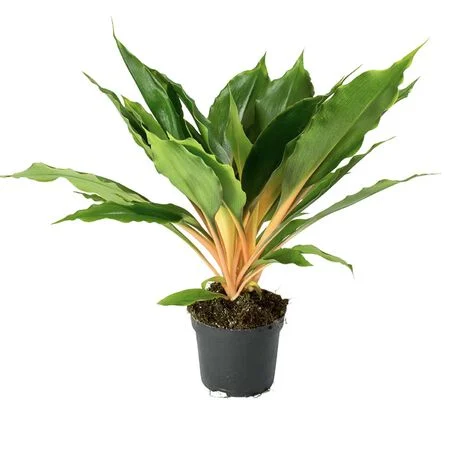
JB274 Princess Mabel Spider Plant ( Chlorophytum )
Princess Mabel is a stunning, Chlorophytum (Spider) plant, with an vigorous upright, habit. Has colorful leaves that have striking bright orange petioles that illuminate the centre of the plant, creating a spectacular contrast with its deep green pointy leaves. Princess Mabel easily adapts to varying dry or humid climate conditions. Chlorophytum is well-known for being an easy-care houseplant with air-purifying qualities. Also known as Manderin plant, Siera Leone lily or Spider plant.
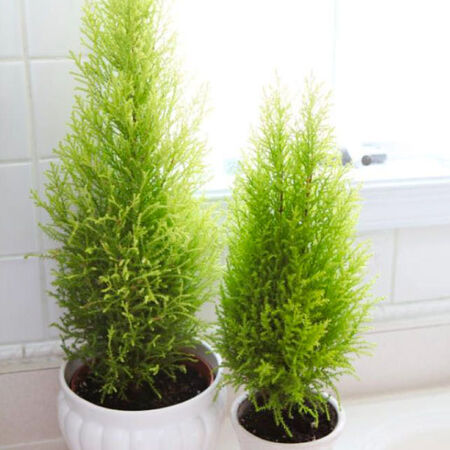
B1749 Monterey Cypress ( Cupressus macrocarpa )
Packs a big punch for a dwarf shrub. Its lovely pyramidal form and vibrant chartreuse foliage are a terrific decorative accent indoors or out. As an added treat, the foliage has a refreshing lemony scent that adds a light touch of fragrance to a room. Growing Cypress in a container limits its growth.If after a few years, you decide to plant it outside, it matures into a beautiful, broad-crowned cypress to more than 75 feet tall. It is a popular ornamental in temperate climates around the world and does particularly well in coastal conditions, holding up remarkably well to wind and salt spray.
In cultivation, it is best suited to temperate climates in USDA hardiness zones 7 to 10.
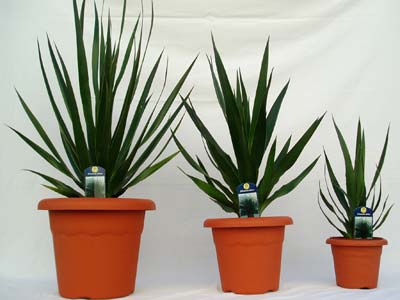
D9918 Large Leaf Dragon Tree ( Dracaena aletriformis )
This relatively fast-growing, beautiful plant requires deep, rich soil and shade. So plant it in fertile, well-drained, compost-enriched soil and keep out of direct sunlight, or the leaves will burn. It requires consistent watering during the growing season and less during winter. It is frost and drought sensitive therefore in colder gardens it will need a very protected position. Due to its tolerance for fairly poor light conditions it makes an exceptional container plant for indoors or for a shady patio providing a bold and attractive focal point.
In South Africa an extract is prepared from its roots to drive away evil spirits, a real bonus feature for an ornamental plant!
In South Africa an extract is prepared from its roots to drive away evil spirits, a real bonus feature for an ornamental plant!
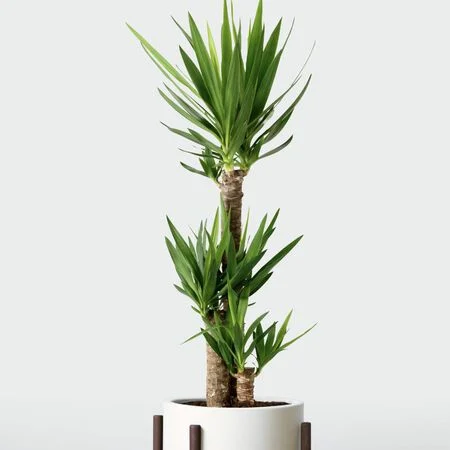
LET701 Blue Stem Yucca ( Yucca spp. )
Blue-Stem Yucca is a super popular houseplant that is easy to grow and needs very little care. They do best in long-lasting, direct light.
Seed Germination: Can take 4-8 weeks to germinate so patience is needed. Plant 1/2" below soil and keep soil 60-70F.
Seed Germination: Can take 4-8 weeks to germinate so patience is needed. Plant 1/2" below soil and keep soil 60-70F.
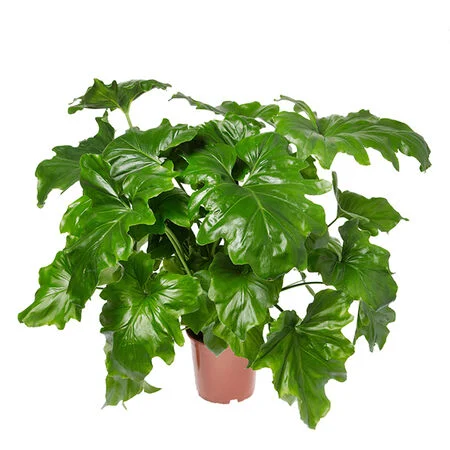
FB139 Selloum Philodendron
This has magnificent foliage with deeply lobed leaves up to 20 inches long and 28 inches
wide. Does well in partial shade and is a good container plant. Eventually forms
palm-like trunk.
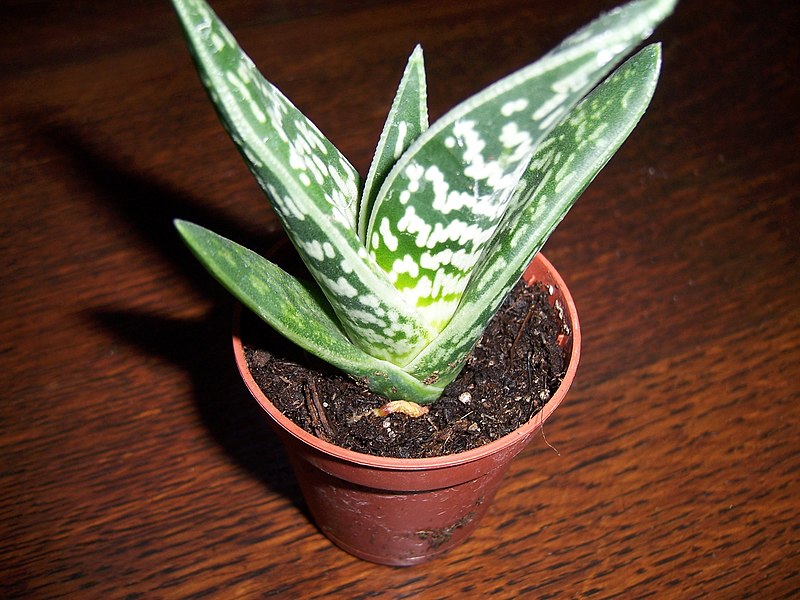
Image:stephen boisvert from Chicago, United States, CC BY 2.0, via Wikimedia Commons
JB271 Aloe Variegata
Aloe variegata commonly called Partridge Breast Aloe makes a great houseplant, but is also hardy if grown outside. This smaller aloe grows to 10 to 12 inches tall to 9 inches wide and forms rosettes, sometimes solitary but often clustered, with leaves arranged in 3 ranks that are upright with a boat-hull shape (lanceolata-deltoid) that have a distinct gutter down the middle. The leaf margins have tiny blunt white teeth along the entire length and are a white color that stands out well against the dark green color of the leaf, which also has short longitudinally-arranged white spots on upper and lower surfaces that often line up in horizontal bands, giving this plant the common name of Tiger Aloe. The spots are also said to resemble those on a partridge breast, which gives this plant its most used common name. The plant will get red highlights that turn the deep green to a more brown color when the plant is drought stressed. The pink to pale red flowers appear on short, stout, and sometimes branched inflorescences. Outside:In the wild, flowering for this plant is noted as responding to rains and in Southern California most find that it flowers in mid-winter. Plant in full coastal sun to shade in a very well-drained soil and irrigate little to occasionally. One cannot seem to underwater this plant but many a grower (us included) will note that this plant can rot out at its base if over irrigated or if soil is not well draining; this being said, others say that they can irrigate with impunity without any problems. It is hardy to around 20 F.
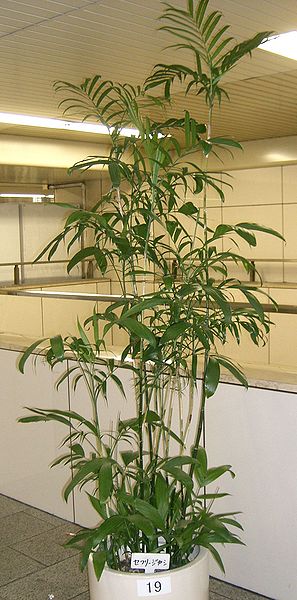
Image: KENPEI [CC BY-SA 3.0], via Wikimedia Commons
IP302 Seifriz's Bamboo Palm ( Chamaedorea seifrizii )
This is a small graceful palm that is commonly used in landscapes and indoor decoration. It is very popular and can be found at most nurseries. It is very easy to grow and maintain.
A shade loving palm particularly suited to growing in pots either indoors or on patios and verandas. Named 'Bamboo Palm' due to its multi-stemmed growth habit, resembling that of bamboo. A great air-purifying plant for indoor spaces and offices.
It can be grown outside in zone 9 and higher, but is most commonly found as houseplant or patio plant.
A shade loving palm particularly suited to growing in pots either indoors or on patios and verandas. Named 'Bamboo Palm' due to its multi-stemmed growth habit, resembling that of bamboo. A great air-purifying plant for indoor spaces and offices.
It can be grown outside in zone 9 and higher, but is most commonly found as houseplant or patio plant.
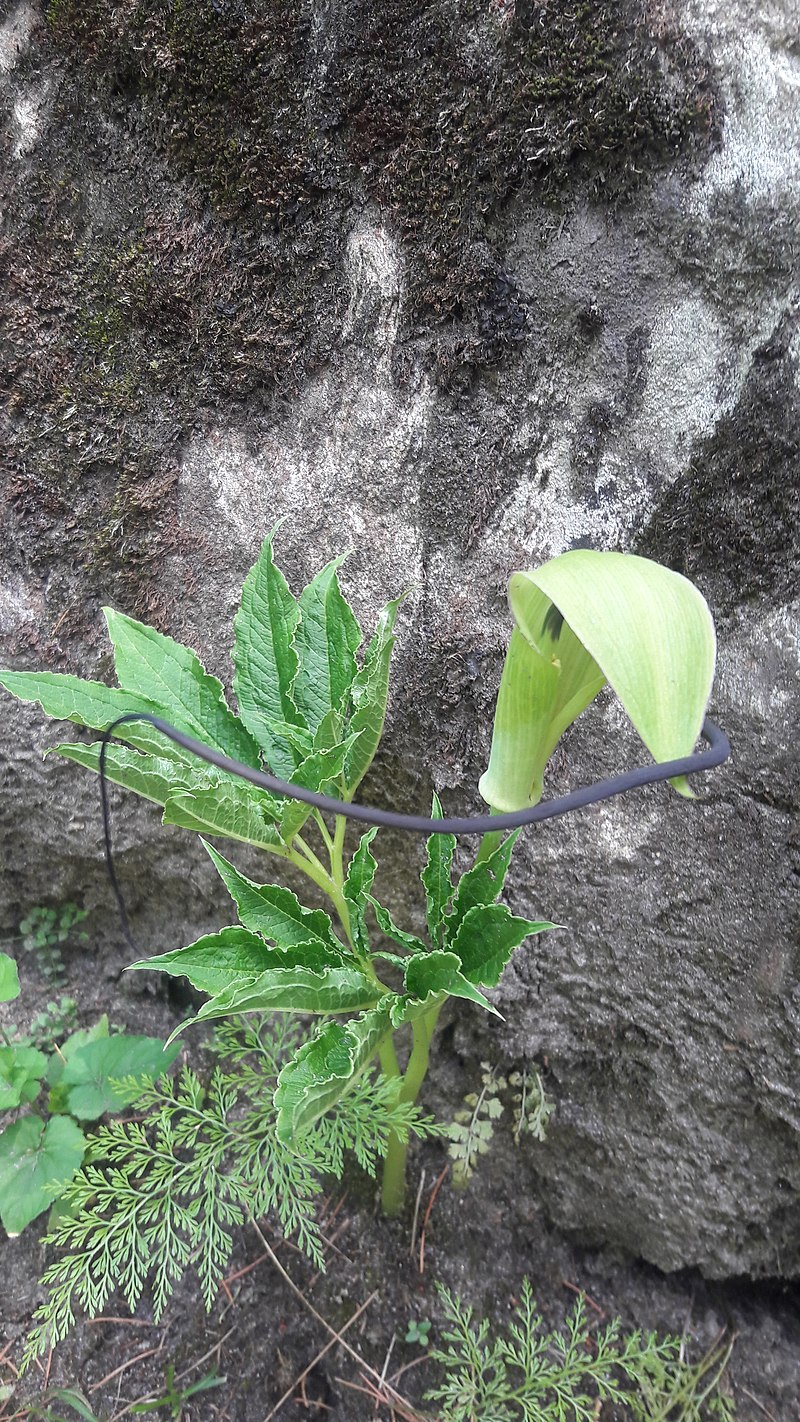
FB166 Whipcord Cobra Lily ( Arisaema tortuosum )
A very weird and unusual houseplant or conversation plant from the Himalayas. Part Sun to Light Shade, does well inside. Zone: 6-9.
Here is one of the true conversation pieces of the aroid world. The thick 4' tall fleshy petiole (stalk) emerges in early June, adorned by two tropical looking palmate green leaves near the top. As the leaves unfurl, the pitcher that tops the stem opens to reveal a green jack-in-the-pulpit flower, but with a whip-like tongue that extends from the mouth of the flower upwards to 12 or more inches.
Flowers may be male or bisexual. The clustered fruits are green at first, ripening to red. The plant grows in large clumps and can be up to 5-6 feet in height.
Needs a constantly moist but well-drained, neutral to acid soil in partial shade and a cool spot.
Flowers may be male or bisexual. The clustered fruits are green at first, ripening to red. The plant grows in large clumps and can be up to 5-6 feet in height.
Needs a constantly moist but well-drained, neutral to acid soil in partial shade and a cool spot.
Z2101 Black Pepper Vine (Piper Nigrum)
A vigorous tropical vine with glossy green leaves grown for commercial production of pepper. Can be grown on trellises outside or used as a houseplant for most regions of US.
Black pepper plants make an attractive addition to your house or garden. Once grown, they develop dainty white flowers before producing fruit. The fruits will appear as clusters of round berries in a chain formation.
Conditions for growing black pepper plants require high temps, heavy and frequent rainfall, and well-draining soil, all of which are met in the countries of India, Indonesia, and Brazil where most of the commercial peppercorns are grown. Most growers in the USA grow these in containers inside the home or greenhouse. These warm loving plants will stop growing when temps drop below 65 degrees F. (18 C.) and do not tolerate frost; as such, they make great container plants. Situate in full sun with 50 percent or greater humidity, or inside the house or greenhouse if your region does not fit these criteria.
In its native habit of southern India, Black Pepper is an understory plant that climbs up trees and grows in dappled light. When grown as a houseplant, it needs moderate light in an east or west window and it should be placed directly on the windowsill or close to your light source if grown in a light garden. It does benefit from some direct sunlight but not hot noonday sun. Like other tropical plants, Black Pepper can be grown outside during the summer months and brought inside for the winter.
The flowers start growing at the leaf nodes of new growth. The small white flowers form pendulous spikes and then small, round, green peppercorns form in chains, which in time ripen to red. Growth slows down in the winter, yet it will fruit and flower year-round. The pepper plant can produce an abundance of peppercorns in a pot as small as 8-inches.
To fertilize, use a soluble or liquid fertilizer applied every two weeks when you water. Don’t over fertilize your black pepper plant, as a rule of thumb, the less light, the less often you fertilize, so outside in summer means more, inside in winter less.
Black pepper plants make an attractive addition to your house or garden. Once grown, they develop dainty white flowers before producing fruit. The fruits will appear as clusters of round berries in a chain formation.
Conditions for growing black pepper plants require high temps, heavy and frequent rainfall, and well-draining soil, all of which are met in the countries of India, Indonesia, and Brazil where most of the commercial peppercorns are grown. Most growers in the USA grow these in containers inside the home or greenhouse. These warm loving plants will stop growing when temps drop below 65 degrees F. (18 C.) and do not tolerate frost; as such, they make great container plants. Situate in full sun with 50 percent or greater humidity, or inside the house or greenhouse if your region does not fit these criteria.
In its native habit of southern India, Black Pepper is an understory plant that climbs up trees and grows in dappled light. When grown as a houseplant, it needs moderate light in an east or west window and it should be placed directly on the windowsill or close to your light source if grown in a light garden. It does benefit from some direct sunlight but not hot noonday sun. Like other tropical plants, Black Pepper can be grown outside during the summer months and brought inside for the winter.
The flowers start growing at the leaf nodes of new growth. The small white flowers form pendulous spikes and then small, round, green peppercorns form in chains, which in time ripen to red. Growth slows down in the winter, yet it will fruit and flower year-round. The pepper plant can produce an abundance of peppercorns in a pot as small as 8-inches.
To fertilize, use a soluble or liquid fertilizer applied every two weeks when you water. Don’t over fertilize your black pepper plant, as a rule of thumb, the less light, the less often you fertilize, so outside in summer means more, inside in winter less.
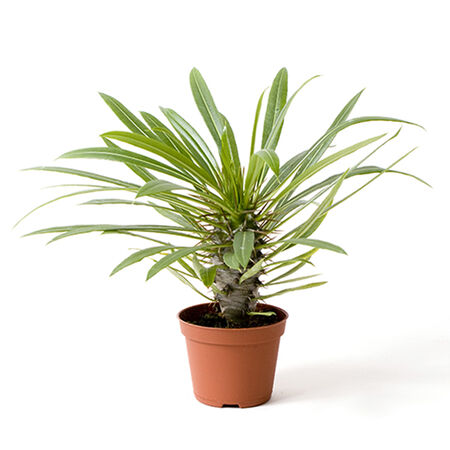
LET698 Madagascar Palm ( Pachypodium lamerei )
Madagascar palm is a stunning succulent with a single, shiny silver, thorny trunk. It is topped with long, slender showy green leaves with a prominent white leaf vein. This plant is tolerant to a wide range of growing conditions and well-resistant to pests and diseases. As a houseplant P. lamerei stays less tall, but it can still grow dramatically over time. In its trunk it stores water, making it a highly water-wise/drought-resistant plant.
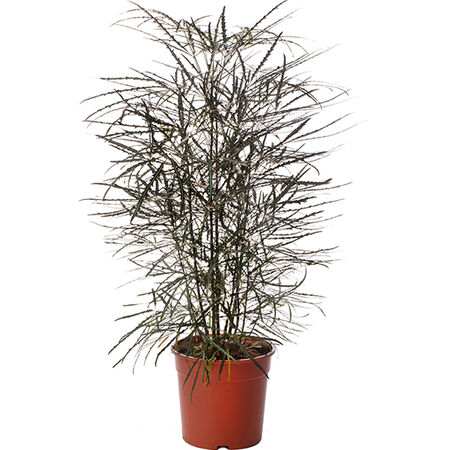
LET699 False Aralia ( Dizygotheca )
False aralia is an elegant shrub or small tree. This beauty plant has narrow, saw-tooth-edged leaves, starting with a metallic reddish color and mature to dark blackish green. As a houseplant it’s easy to prune to keep it tall and slender or short and compact. Also known as Elegant schefflera; Finger or Spider aralia.
Seed Germination: Sow seeds on the surface of a moist seed-starting mix, as they need light to germinate. Make sure to keep soil warm above 70F. Can take between 14-28 days to germinate.
Seed Germination: Sow seeds on the surface of a moist seed-starting mix, as they need light to germinate. Make sure to keep soil warm above 70F. Can take between 14-28 days to germinate.
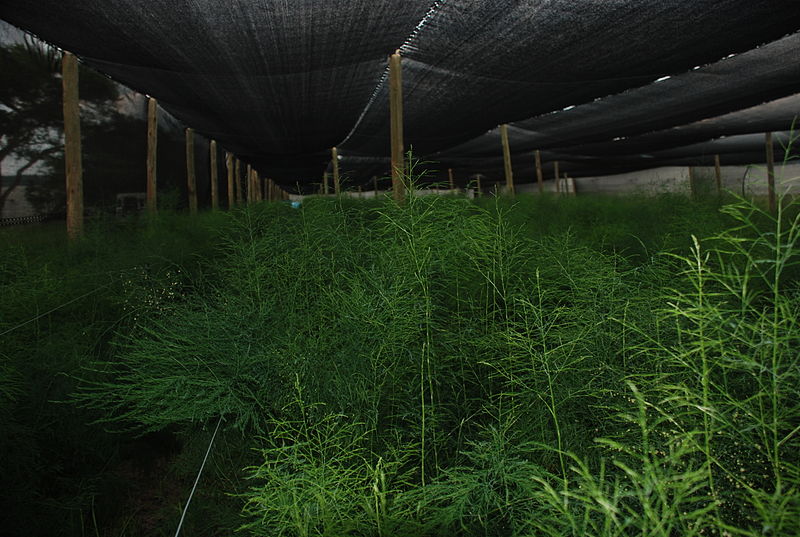
Image: By Johann.rademeyer [CC BY-SA 3.0 (https://creativecommons.org/licenses/by-sa/3.0)], from Wikimedia Commons
JB289 Tree Fern ( Asparagus Virgatus )
While it makes a great, carefree houseplant, this is also a popular plant used for its long-lasting cut foliage, making it ideal for flower arrangements.
Also known as African Broom Fern. A relative of the Asparagus fern, this plant grows more like a bush with many graceful fronds. An excellent compliment plant for a ficus.
Even though native to Yemen on the Arabian Peninsula, eastern and southern Africa, this fern-like, small Asparagus is surprisingly cold hardy and suitable for temperate climates down to USDA Zone 7. It forms much and finely branched, feathery shoots to rarely more than 3 feet tall. It is popular as a landscaping plant but also widely grown for cut foliage.
This beautiful tropical palm/ornamental plant is most commonly found in households and gardens. It is suitable for indoor and outdoor decoration.
Also known as African Broom Fern. A relative of the Asparagus fern, this plant grows more like a bush with many graceful fronds. An excellent compliment plant for a ficus.
Even though native to Yemen on the Arabian Peninsula, eastern and southern Africa, this fern-like, small Asparagus is surprisingly cold hardy and suitable for temperate climates down to USDA Zone 7. It forms much and finely branched, feathery shoots to rarely more than 3 feet tall. It is popular as a landscaping plant but also widely grown for cut foliage.
This beautiful tropical palm/ornamental plant is most commonly found in households and gardens. It is suitable for indoor and outdoor decoration.
Harvest asparagus material early in the morning. Select mature stems for longest lasting vase life.
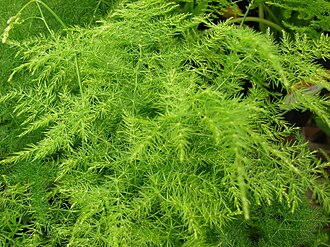
LET875 Climbing Lace Fern ( Asparagus setaceus )
More upright and with a bit more twinging habit than common Asparagus Fern, Climbing Lace Fern is cultivated as an ornamental plant, for planting in garden and containers, and as a house plant. The attractive foliage is also used in floral arrangements. It is hardy to 34°F, but does not tolerate being frozen. Therefore in temperate zones it is normally cultivated indoors in bright, indirect light.
This plant has gained the Royal Horticultural Society's Award of Garden Merit.
Where winter hardy, grow along fences or as a wall screen. Good houseplant for bright, sun-filtered areas. Good for hanging baskets. Green stems are valued by florists as showy additions to flower arrangements.
Seed Germination: Plant at least 2-3 seeds per pot. Bottom heat is helpful. Takes 14-30 days to germinate.
This plant has gained the Royal Horticultural Society's Award of Garden Merit.
Where winter hardy, grow along fences or as a wall screen. Good houseplant for bright, sun-filtered areas. Good for hanging baskets. Green stems are valued by florists as showy additions to flower arrangements.
Seed Germination: Plant at least 2-3 seeds per pot. Bottom heat is helpful. Takes 14-30 days to germinate.
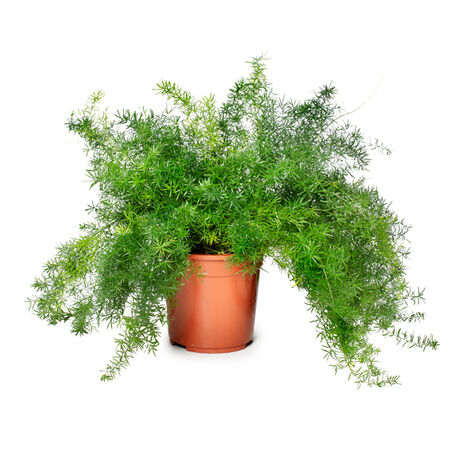
LET700 Mazeppa Asparagus Fern ( Asparagus spp. )
Mazeppa is a low-growing decorative foliage plant, with a compact habit. This robust Asparagus has arching woody stems with fine fern-like leaves. Mazeppa adjusts well to different climates and does great as a houseplant. Helps purify indoor air. a.k.a. Mazeppa emerald fern, Asparagus fern, Emerald fern or Basket asparagus.
Seed Germination: Plant at least 2-3 seeds per pot. Bottom heat is helpful. Takes 14-30 days to germinate.
Seed Germination: Plant at least 2-3 seeds per pot. Bottom heat is helpful. Takes 14-30 days to germinate.

2044 Ming Fern ( Asparagus myriocladus )
The Ming fern is a beautiful plant with bright green puffy clusters of soft green needles. One of the favorite Asparagus ferns for cutting and growing as a houseplant. A wonderful
acccent plant.
A finely textured subtropical foliage plant, with a bushy, compact habit. This Asparagus had strong woody stems and fluffy green tufts. It has tiny, bright green, needle-like foliage. Can be used as an ornamental houseplant or as filler foliage in cut flower bouquets. Great at cleaning air within the home. It is commonly known as Ming fern, Dill fern or Asparagus fern.
A finely textured subtropical foliage plant, with a bushy, compact habit. This Asparagus had strong woody stems and fluffy green tufts. It has tiny, bright green, needle-like foliage. Can be used as an ornamental houseplant or as filler foliage in cut flower bouquets. Great at cleaning air within the home. It is commonly known as Ming fern, Dill fern or Asparagus fern.
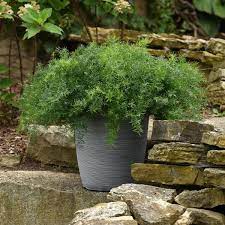
LET764 Fuzzyfern Frizz Asparagus Fern ( Asparagus densiflorus )
This new Asparagus Fern features long graceful needle-like sprays for baskets. Frizz brings a fun texture to mixed containers, hanging baskets, indoor applications, and landscapes. This trailing foliage item can handle both sun and shade plus indoor and outdoor use for more versatility.
In zones 9 to 11 (very tropical areas) it can be used in the landscape year around. In zones 7 to 8, it may be root hardy and come back the following year. In all other zones, it will have to be used as a summer annual, similar to Petunias and Impatiens.
In zones 9 to 11 (very tropical areas) it can be used in the landscape year around. In zones 7 to 8, it may be root hardy and come back the following year. In all other zones, it will have to be used as a summer annual, similar to Petunias and Impatiens.
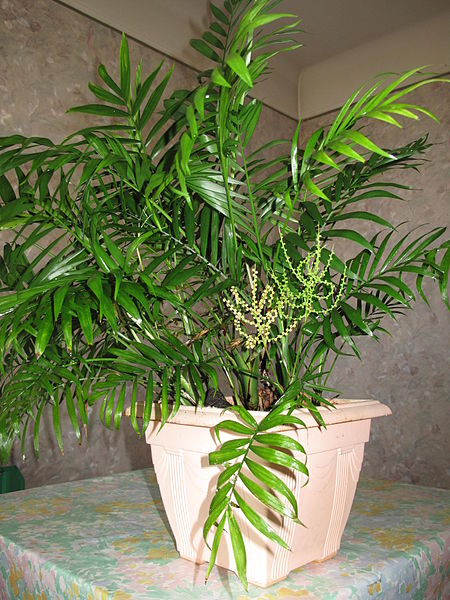
TCB040 Parlour Palm ( Chamaedorea elegans )
The parlour palm is species of small palm tree native to the rainforests in Southern Mexico and Guatemala. The parlor palm is one of the most heavily sold houseplant palms in the world. It is one of several species with leaves that are harvested as xate.
It is used in gardens in sub-tropical climates, such as the Southeastern United States, and in tropical areas, growing to 6-7 feet tall inside, ( may reach about 12 feet outside in zones 9 and higher ) with slender, cane-like stems.
It is often cultivated in temperate regions as a houseplant, where it grows to 6 feet tall with very slow growth, tolerating low levels of humidity and light, though it prefers medium to high humidity and bright indirect light.
It is a versatile and almost no-maintenance plant that is able to grow in most indoor and outdoor conditions. These plants are not tolerant of frost and must be kept indoors in winter in non-tropical climates.
It is used in gardens in sub-tropical climates, such as the Southeastern United States, and in tropical areas, growing to 6-7 feet tall inside, ( may reach about 12 feet outside in zones 9 and higher ) with slender, cane-like stems.
It is often cultivated in temperate regions as a houseplant, where it grows to 6 feet tall with very slow growth, tolerating low levels of humidity and light, though it prefers medium to high humidity and bright indirect light.
It is a versatile and almost no-maintenance plant that is able to grow in most indoor and outdoor conditions. These plants are not tolerant of frost and must be kept indoors in winter in non-tropical climates.

Image: DaffaHapidzK [CC BY-SA 4.0], via Wikimedia Commons
D9608 Sealing Wax Palm ( Cyrtostachys lakka )
A stunning feather palm with a bright red trunk. Cyrtostachys renda, commonly called lipstick palm or sealing wax palm, is a tropical palm that is native to swampy rain forest areas of the Malaysian peninsula, Indonesia and Borneo. It is perhaps best known for its glossy scarlet red crown shafts and leaf stalks which bring stunning accent and contrast to landscapes or indoor areas. Common names are in reference to the red coloration. In the wild, this palm will grow to 12-15’ tall. Pinnate leaves to 4-5’ long are deep green above and gray-green underneath. Small greenish white flowers in panicles bloom in summer.
It makes a good houseplant if grown in small tubs and a great patio plant if brought in during cold weather, it does not like tempeatures below 50 degrees. Zones 10b and higher outside, most commonly grown as houseplant or patio plant in cooler zones.
It makes a good houseplant if grown in small tubs and a great patio plant if brought in during cold weather, it does not like tempeatures below 50 degrees. Zones 10b and higher outside, most commonly grown as houseplant or patio plant in cooler zones.
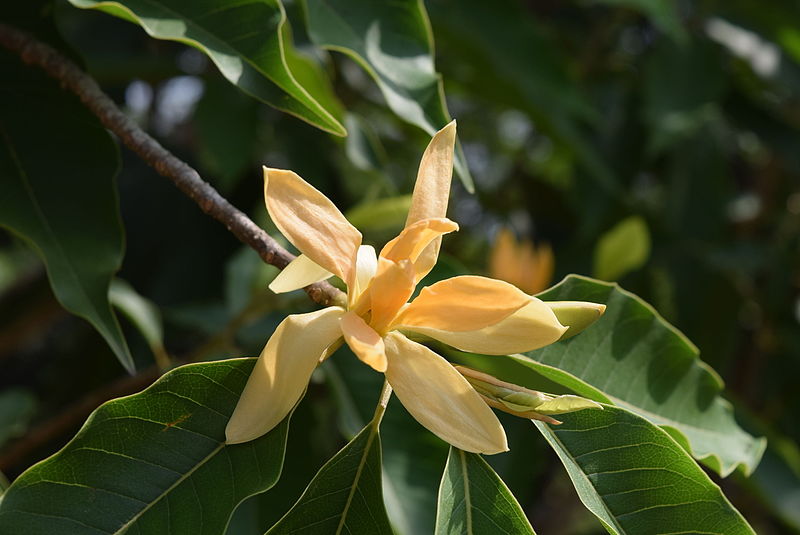
Image: Varun Pabrai, CC BY-SA 4.0, via Wikimedia Commons
IP150 Joy Perfume Tree ( Michelia champaca )
Syn. Magnolia champaca. Excellent houseplant for colder zones or garden plant for warmer zones ( 10 and above ). The fragrance of the flower is simply amazing.
Also known as Champa, Yellow Champa, Golden Campa or Fragrant Champa is highly revered by the followers of Hinduism and Buddhism. They use Michelia flowers during religious ceremonies. Tibetans believe that the Buddha of the next era will find enlightenment under the flower canopy of the champaca tree.
Michelia has several ornamental, commercial and medicinal uses too. For gardeners, it is an excellent choice as a houseplant or as companion plant in landscapes. Commercially, the timber of Michelia is used for almost anything from cabinet-making to firewood and flowers are grown to sell at cut flower shops. The extract from the flowers of Michelia Alba is used in preparation of the famous 'Joy' perfume. Medicinally, the tree has wide applications; the bark is used to prepare tonic, the oil extracted from flowers is used to cure toughs and rheumatism, and for relieving eye troubles and gout.
Michelias are easy to grow and maintain. They love a lot of light and warmth but filtered sunlight. The best location for Michelia is the place where it receives direct and ample sunlight in early morning but partial light for the rest of the day. Suitable for containers, Michelias has shallow and brittle root system. It likes moderate watering in acidic and well-drained soil. As a general rule, water lavishly when the plant is young to allow it to develop good root system. Water mature trees moderately and feed with a general purpose fertilizer during spring. Prune in winter when plant goes dormant.
Outdoors in zone 10 or higher, Michelia can gain a height of 75 feet or more in suitable conditions. The tree bears large leaves that resemble the leaves of Mango tree. The tree booms from May to October and produces abundance of star-shaped flowers that fill the entire surrounding with mesmerizing scent. Flowers are usually golden-yellow, golden-orange and creamy-white.
Also known as Champa, Yellow Champa, Golden Campa or Fragrant Champa is highly revered by the followers of Hinduism and Buddhism. They use Michelia flowers during religious ceremonies. Tibetans believe that the Buddha of the next era will find enlightenment under the flower canopy of the champaca tree.
Michelia has several ornamental, commercial and medicinal uses too. For gardeners, it is an excellent choice as a houseplant or as companion plant in landscapes. Commercially, the timber of Michelia is used for almost anything from cabinet-making to firewood and flowers are grown to sell at cut flower shops. The extract from the flowers of Michelia Alba is used in preparation of the famous 'Joy' perfume. Medicinally, the tree has wide applications; the bark is used to prepare tonic, the oil extracted from flowers is used to cure toughs and rheumatism, and for relieving eye troubles and gout.
Michelias are easy to grow and maintain. They love a lot of light and warmth but filtered sunlight. The best location for Michelia is the place where it receives direct and ample sunlight in early morning but partial light for the rest of the day. Suitable for containers, Michelias has shallow and brittle root system. It likes moderate watering in acidic and well-drained soil. As a general rule, water lavishly when the plant is young to allow it to develop good root system. Water mature trees moderately and feed with a general purpose fertilizer during spring. Prune in winter when plant goes dormant.
Outdoors in zone 10 or higher, Michelia can gain a height of 75 feet or more in suitable conditions. The tree bears large leaves that resemble the leaves of Mango tree. The tree booms from May to October and produces abundance of star-shaped flowers that fill the entire surrounding with mesmerizing scent. Flowers are usually golden-yellow, golden-orange and creamy-white.
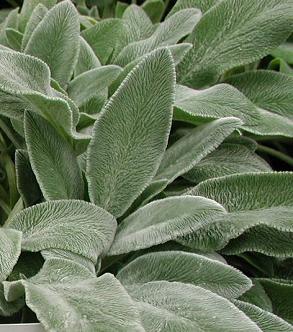
IP186 Fuzzy Wuzzy Lambs Ear ( Stachys byzantina )
Velvety soft,silver-gray leaves are shaped and feel like a lamb's ear. Lavender flower on short spikes in July. Tolerates drought, heat and humidity.
Lamb's-ears are one of the most popular foliage perennials, used widely for edging along pathways and borders.
This strain forms a dense carpet of soft and fuzzy silver leaves, bearing upright spikes of magenta-lavender flowers in early summer. Clip spent bloom stems off to tidy up the clumps for the rest of the season. Drought tolerant once established.
Clumps are easily divided in spring or early fall. Evergreen in mild winter regions.
Zones 3-9.
Lamb's-ears are one of the most popular foliage perennials, used widely for edging along pathways and borders.
This strain forms a dense carpet of soft and fuzzy silver leaves, bearing upright spikes of magenta-lavender flowers in early summer. Clip spent bloom stems off to tidy up the clumps for the rest of the season. Drought tolerant once established.
Clumps are easily divided in spring or early fall. Evergreen in mild winter regions.
Zones 3-9.
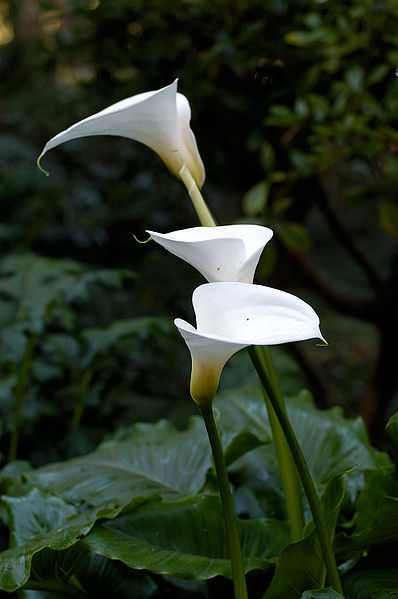
3466 Cream White Calla Lily ( Zantedeschia Aethiopica )
Very hard to find seeds for this cream white variety. This is a wonderful houseplant, The immaculate spathes and decorative leaves of callas have long made these members of the aroid tribe favorites for the house. What is generally regarded as the flower is really a modified leaf or spathe. The small flowers are borne on the club-like appendage (spadix) which arises from the center of the spathe. Two types of flowers are grouped about each spadix; pollen-bearing male flowers on the upper half, and female on the lower. The large leaves are often embellished with translucent spots, and are useful in flower arrangements with other cut flowers, as well as with callas.
Outside: In USDA zones 8 and 9, you can leave Callas in the ground year around. In cooler zones, they should be dug in the fall and brought inside.
Outside: In USDA zones 8 and 9, you can leave Callas in the ground year around. In cooler zones, they should be dug in the fall and brought inside.
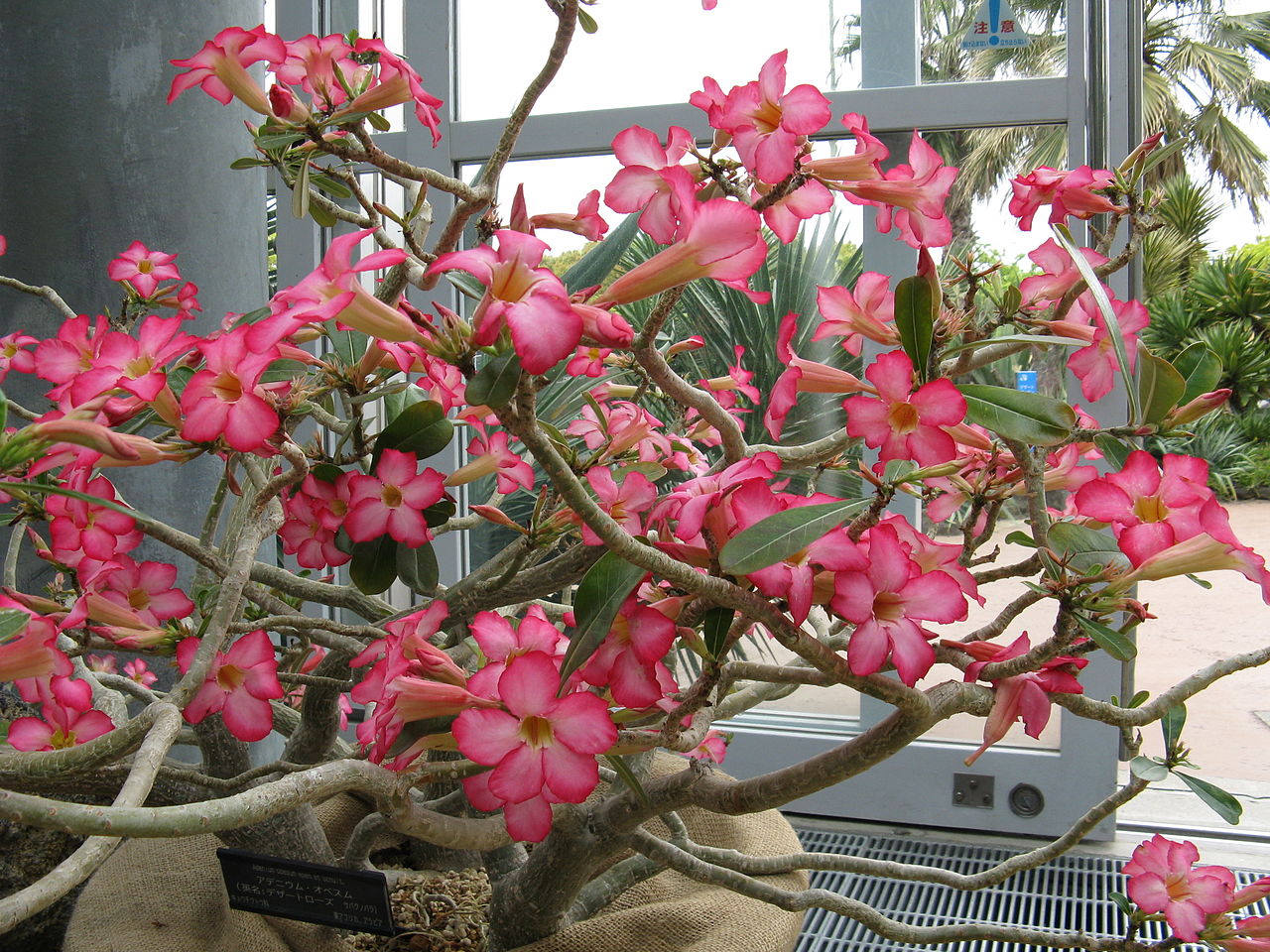
3557 Desert Rose ( Adenium obesum )
If you would like to grow a gorgeous houseplant requiring very little care, you cannot go wrong with the common Desert Rose plant.
This carefree succulent boasts an unusual trunk (caudex) shape coupled with bunches of beautiful, colorful, trumpet-shaped flowers in an abundance of carmine-rose colors.
The plant makes an excellent warm-weather addition to your patio, deck or landscape, and it also does very well as a bonsai or houseplant.
Winter hardy to Zone 11. In colder zones, plants should be grown in containers and overwintered indoors. In containers, desert rose is best grown in a loose, sandy or gravelly, well-drained soil mix in full sun. Plants have excellent heat tolerance. Apply regular moisture during periods of growth, but allow soils to dry between waterings. Regular applications of fertilizer in spring will help promote flowering. Plants can be left outdoors in sunny locations during the summer. As soon as temperatures begin to dip below 55 degrees F. in autumn, bring containers indoors to sunny but cool locations with reduced watering. Plants usually lose their leaves in winter and go into a dormancy-like period. For container plants, the best caudex usually develops from seed-grown plants.
This carefree succulent boasts an unusual trunk (caudex) shape coupled with bunches of beautiful, colorful, trumpet-shaped flowers in an abundance of carmine-rose colors.
The plant makes an excellent warm-weather addition to your patio, deck or landscape, and it also does very well as a bonsai or houseplant.
Winter hardy to Zone 11. In colder zones, plants should be grown in containers and overwintered indoors. In containers, desert rose is best grown in a loose, sandy or gravelly, well-drained soil mix in full sun. Plants have excellent heat tolerance. Apply regular moisture during periods of growth, but allow soils to dry between waterings. Regular applications of fertilizer in spring will help promote flowering. Plants can be left outdoors in sunny locations during the summer. As soon as temperatures begin to dip below 55 degrees F. in autumn, bring containers indoors to sunny but cool locations with reduced watering. Plants usually lose their leaves in winter and go into a dormancy-like period. For container plants, the best caudex usually develops from seed-grown plants.

Image: Matti Blume, CC BY-SA 4.0, via Wikimedia Commons
P28 Canary Island Date Palm ( Phoenix canariensis )
From the Canary Islands off the Coast of Africa, this palm is
widely grown as an ornamental tree. It is tolerant of cold and
drought and can be easily raised from seeds if given heat.
Outside, it will grow up to 60 ft. with a 3 ft. diameter trunk.
Inside, its growth can be regulated by the size of container it
is raised in. It has a distinctive spiky, architectural
appearance that is a must for any home. It bears 2 in. long
fruit that is orange when ripe. The old leaf scars on the trunk
form diamond shaped patterns. Cold hardy to 20 degrees.
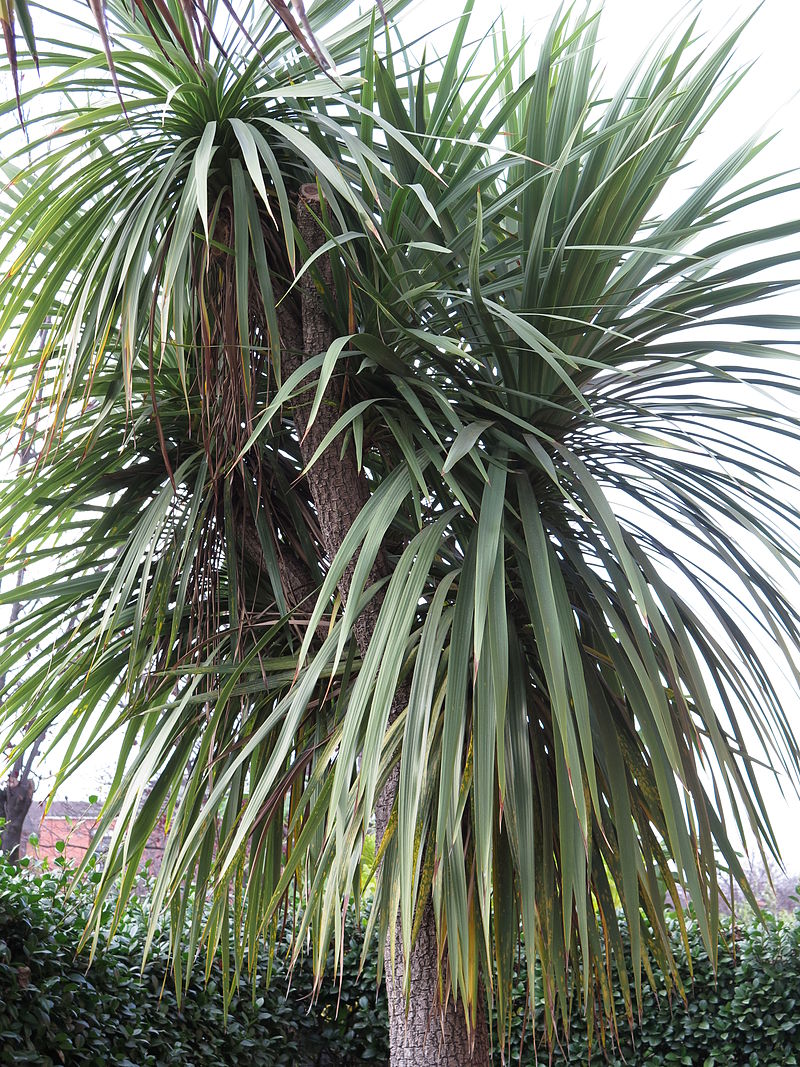
SF365 Cabbage Tree Palm ( Cordyline
australis )
A must for every house plant collection. The Cabbage Tree Palm makes a beautiful container plant that is easy to care for. Its long slender grass fingers make for a perfect false palm. It is fast growing and tolerates abuse and low light. It is low maintenance and long lived.
It is one of the best known and most recognized of the plants indigenous to New Zealand where it typically grows as a single or multiple-trunked tree to 20-30' tall. It was introduced into the U.S in the early 1800s and now grows in a number of locations in California and the southern U.S. It features sword-shaped gray-green leaves to 3 feet long and only 2-3 inches wide. Impressive panicles of small fragrant white flowers bloom in late spring to early summer, however container-grown plants rarely flower. Young plants feature a fountain of grass-like leaves with no trunk and are often sold in this form as houseplants. Patio container plants will slowly develop a cane-like trunk or trunks over time, eventually growing to as much as 15’ tall.
Zone 9 or higer outside.
It is one of the best known and most recognized of the plants indigenous to New Zealand where it typically grows as a single or multiple-trunked tree to 20-30' tall. It was introduced into the U.S in the early 1800s and now grows in a number of locations in California and the southern U.S. It features sword-shaped gray-green leaves to 3 feet long and only 2-3 inches wide. Impressive panicles of small fragrant white flowers bloom in late spring to early summer, however container-grown plants rarely flower. Young plants feature a fountain of grass-like leaves with no trunk and are often sold in this form as houseplants. Patio container plants will slowly develop a cane-like trunk or trunks over time, eventually growing to as much as 15’ tall.
Zone 9 or higer outside.
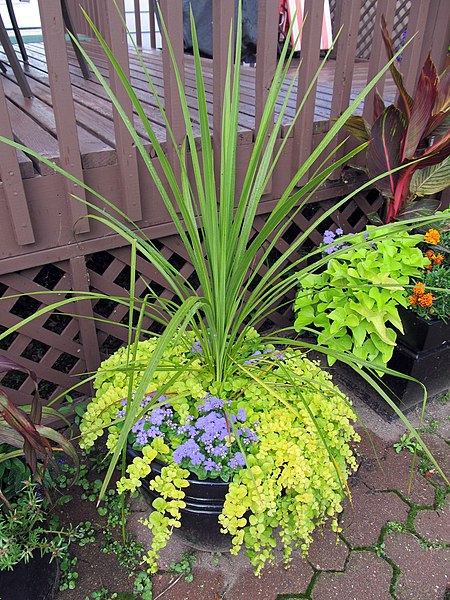
Image: daryl_mitchell from Saskatoon, Saskatchewan, Canada, CC BY-SA 2.0, via Wikimedia Commons
LET694 Spikes ( Cordyline indivisa )
This is a great patio plant and a a wonderful houseplant when grown in containers inside. This is the quickest growing strain of Cordyline indivisa and has smaller, more slender leaves.
A slow-growing evergreen tree, the Cordyline indivisa is commonly referred to as the mountain cabbage tree, blue dracaena, or Toi in its native New Zealand. These easy-to-grow trees were introduced to the United States during the 1800s and now add tropical flair to temperate gardens. A container plant to be enjoyed outdoors on the patio in the summer, as well as kept indoors year-round. Outside, it could grow to 10 feet or so tall, but grown in containers, it will stay much smaller, limited by the size of the container.
Zones 8-12 outside, but almost anywhere when grown in containers inside.
A slow-growing evergreen tree, the Cordyline indivisa is commonly referred to as the mountain cabbage tree, blue dracaena, or Toi in its native New Zealand. These easy-to-grow trees were introduced to the United States during the 1800s and now add tropical flair to temperate gardens. A container plant to be enjoyed outdoors on the patio in the summer, as well as kept indoors year-round. Outside, it could grow to 10 feet or so tall, but grown in containers, it will stay much smaller, limited by the size of the container.
Zones 8-12 outside, but almost anywhere when grown in containers inside.
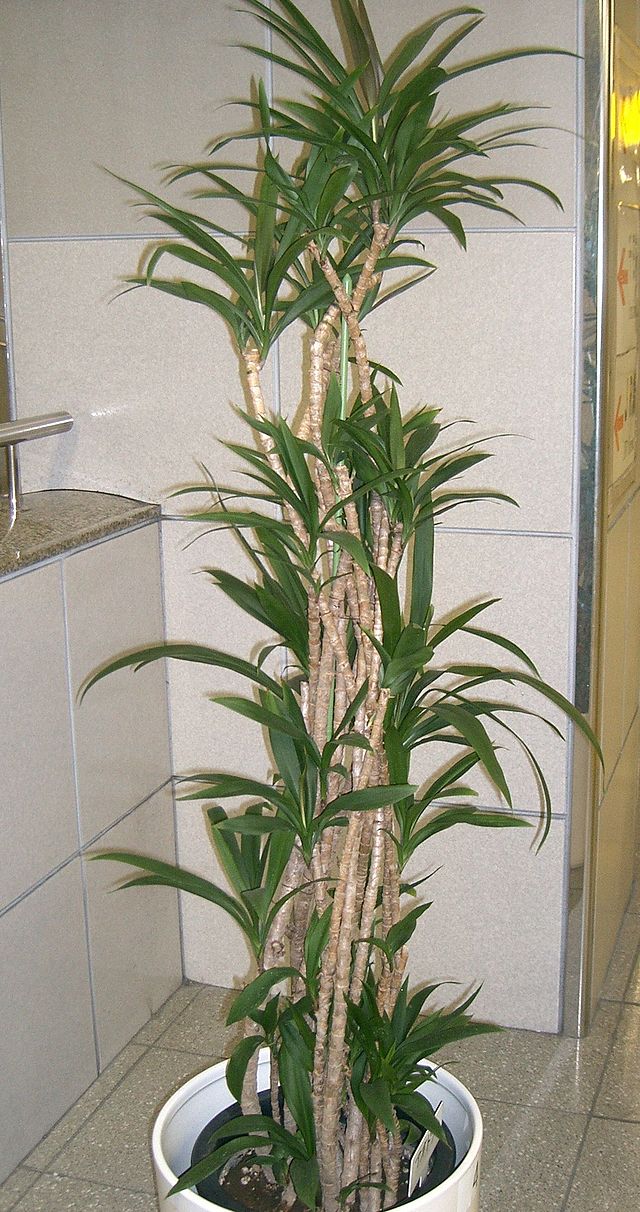
Image:KENPEI, CC BY-SA 3.0, via Wikimedia Commons
LET804 Slender Palm Lily ( Cordyline stricta )
A nice accent plant for a bright shady spot in the garden or used as a container plant, indoors or out.
Showy inflorescences with bluish flowers are produced in spring. Cordyline stricta adapts well to both tropical and mild temperate climates and can take light freezes unharmed. It does best under filtered light, making it a nice houseplant specimen. Makes an excellent container plant and can be kept indoors for long periods. The plant can be pruned to any height and will reshoot readily
Great inside or patio plant, or can be grown full time outdoors in zones 8-11.
Showy inflorescences with bluish flowers are produced in spring. Cordyline stricta adapts well to both tropical and mild temperate climates and can take light freezes unharmed. It does best under filtered light, making it a nice houseplant specimen. Makes an excellent container plant and can be kept indoors for long periods. The plant can be pruned to any height and will reshoot readily
Great inside or patio plant, or can be grown full time outdoors in zones 8-11.
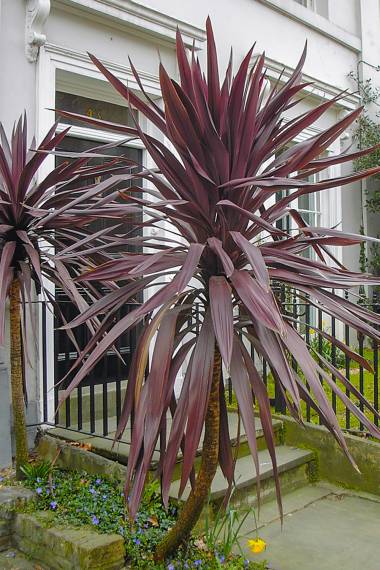
JB220 Bronze Spike ( Cordyline atropurpurea )
Also known as Purple Dragon Tree. This is a great houseplant, or patio tub plant with a unique look. A good container plant when young, and makes an architectural tree when mature.
Sun loving drought tolerant plant for patio, container or outside. Ornamental bark and striking foliage for all year round color and screening. Will stay smaller in container, will grow to about 12 feet outside when mature. This palm-like sub-tropical tree makes a striking focal plant with its fountain of arching bright burgundy and reddish-bronze sword-like leaves. For a more graceful plant, cut back when young to force multiple trunks. Mature plants bear clusters of small, starry, fragrant white flowers in late spring.
Also recognized as Cordyline australis 'Atropurpurea', this is a popular, naturally occurring cultivar which is purple leaved and slightly shorter than the original species.
Great inside or patio plant, or can be grown full time outdoors in zones 9-10.
Sun loving drought tolerant plant for patio, container or outside. Ornamental bark and striking foliage for all year round color and screening. Will stay smaller in container, will grow to about 12 feet outside when mature. This palm-like sub-tropical tree makes a striking focal plant with its fountain of arching bright burgundy and reddish-bronze sword-like leaves. For a more graceful plant, cut back when young to force multiple trunks. Mature plants bear clusters of small, starry, fragrant white flowers in late spring.
Also recognized as Cordyline australis 'Atropurpurea', this is a popular, naturally occurring cultivar which is purple leaved and slightly shorter than the original species.
Great inside or patio plant, or can be grown full time outdoors in zones 9-10.
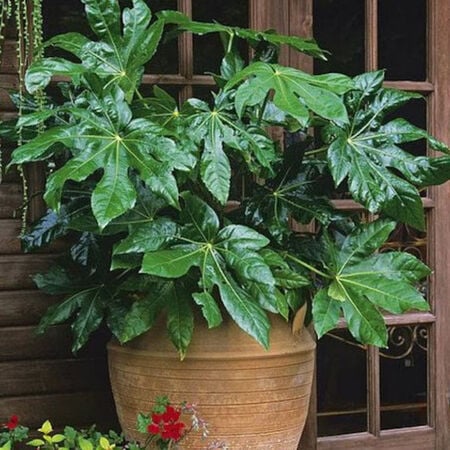
Image:Emőke Dénes, CC BY-SA 4.0, via Wikimedia Commons
JB266 Japanese Arailia ( Fatsia japonica )
A very versatile plant for indoor and outdoor use. Large, exotic, rich green foliage adds an exciting and bold tropical look to landscapes and patios. Great in a shaded entryway or patio, or in a sheltered spot near a water garden or dipping pool. Perfect for outdoor containers or as a houseplant. Ideal for low light, urban settings. Winter flowers are followed by black ornamental berries. Evergreen. One of the most familiar house plants around. Its huge star shaped leaves will decorate any patio or hallway. It also makes a good yard plant if given lots of light. Zones 8A-11 outside.
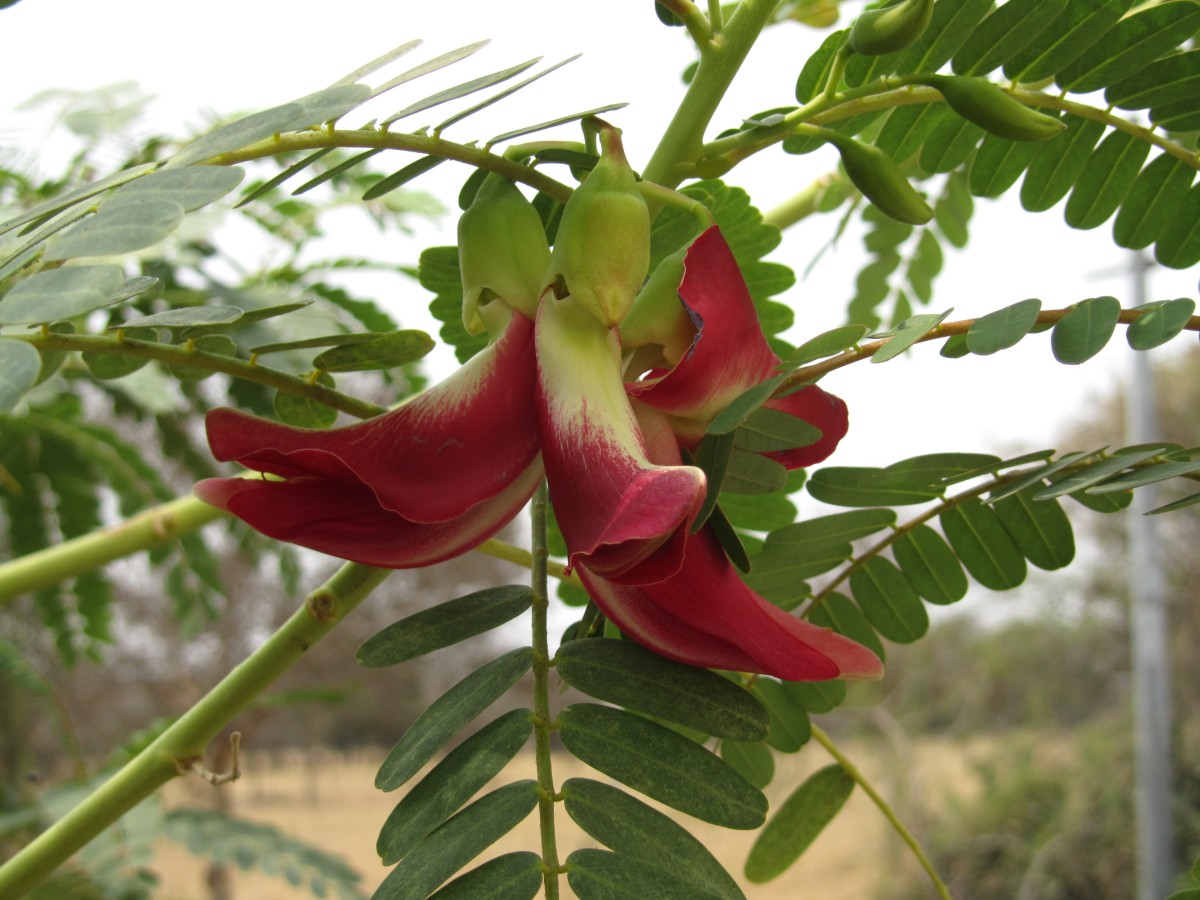
Image: Viky.nandha, CC BY-SA 3.0, via Wikimedia Commons
JB110 Hummingbird Tree ( Sesbania Grandiflora )
Seen from a distance, the Hummingbird Tree's clusters of bright red flowers resemble a group of fluttering hummingbirds hovering around your tree. Hummingbird Trees can produce blooms in varying hues of red, white and pink, and this red-flowering variety will pack a unique and colorful look in your home or yard.
It is also known as the Vegetable Hummingbird Tree as it's leaves, flowers, and fruits can all be consumed. You cam enjoy them raw, or toss them into soups, stews, and stir fry dishes for extra nutritional value. It also has medicinal uses, beloved in Southeast Asia for teas and salves.
This is a somewhat tropical plant best suited for zones 9-11 outside, but it does very well inside in containers, and blooms well in pots and tubs. Will grow 40 feet tall in warm zones, but will limit it's size inside to the size container it is grown in.
It has fern-like fronds in a vibrant green color. Bright red flowers are followed by green fruit pods that grow up to 23 inches long, complementing the tree’s droopy canopy look. This beautiful tree will attract hummingbirds and pollinators, and its timber can even be used for woodworking. As a fully grown tree, it provides excellent shade for seating areas or low-growing plants at its base.
It is also known as the Vegetable Hummingbird Tree as it's leaves, flowers, and fruits can all be consumed. You cam enjoy them raw, or toss them into soups, stews, and stir fry dishes for extra nutritional value. It also has medicinal uses, beloved in Southeast Asia for teas and salves.
This is a somewhat tropical plant best suited for zones 9-11 outside, but it does very well inside in containers, and blooms well in pots and tubs. Will grow 40 feet tall in warm zones, but will limit it's size inside to the size container it is grown in.
It has fern-like fronds in a vibrant green color. Bright red flowers are followed by green fruit pods that grow up to 23 inches long, complementing the tree’s droopy canopy look. This beautiful tree will attract hummingbirds and pollinators, and its timber can even be used for woodworking. As a fully grown tree, it provides excellent shade for seating areas or low-growing plants at its base.
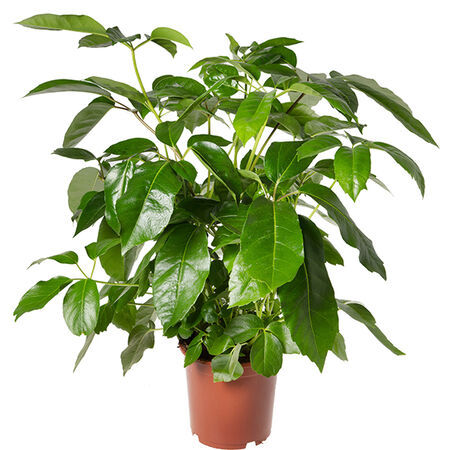
D5147 Schefflera, Octopus Plant ( Schefflera )
A stunning, tropical shrub or tree with a vigorous habit. This beautiful Schefflera has a natural glossy look and long, oblong leaves. The shiny green, leathery leaves are arranged on their slender stalks like an umbrella, or like fingers on a hand. As a houseplant Schefflera is super versatile and it adapts well to various conditions. Schefflera is easy to prune to any size you want. Keep it tall and slender to offer it as a tree-like stunner to cover a corner from floor to ceiling. In addition, Schefflera is a great air-purifier.
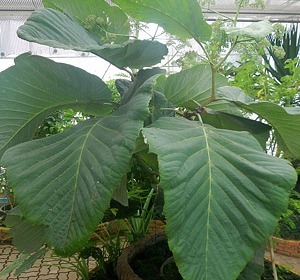
3546 Elephant Ear Tree ( Leea macrophylla )
A very beautiful, upright, herbaceous shrub or small tree with spectacular, very large leaves to 24 inches across and a thick, fleshy rootstock.
Native to India, Nepal, southwestern China and Southeast Asia, it is occasionally planted as an ornamental and as a unique patio and houseplant. The leaves are edible as a vegetable but of limited palatability. Leea macrophylla has also been investigated for anti-cancer properties and is used in traditional medicine.
Zone 10 and higher outside, or inside in warm brightly lit areas.
Native to India, Nepal, southwestern China and Southeast Asia, it is occasionally planted as an ornamental and as a unique patio and houseplant. The leaves are edible as a vegetable but of limited palatability. Leea macrophylla has also been investigated for anti-cancer properties and is used in traditional medicine.
Zone 10 and higher outside, or inside in warm brightly lit areas.
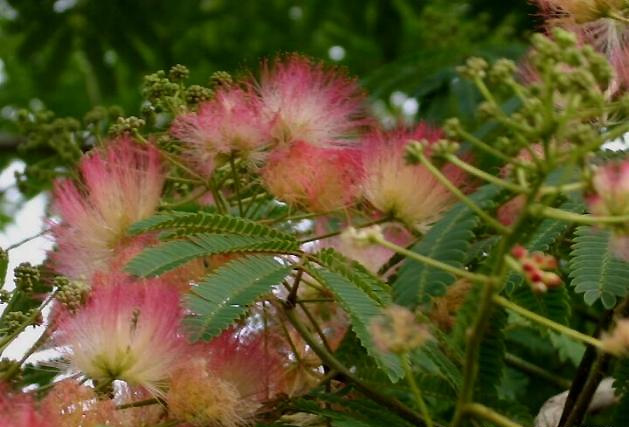
D1160 Silk Tree ( Albizia julibrissin )
From Iran. A beautiful tree when raised outside, this tree also
makes a wonderful tub plant. Has graceful, feathery foliage and
pink, yellow or white plume like flowers. The leaves are
aromatic and used in Chinese cooking. Hardy outside to New
England. The leaflets fold up at night.
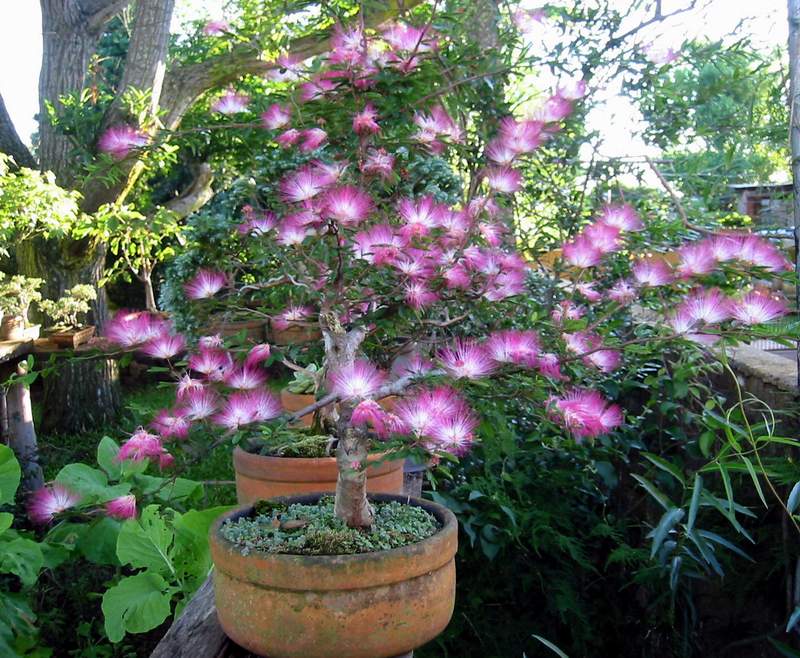
Image:
Author: Andreas D. on flickr.
Wikimedia Source: https://www.flickr.com/photos/spengler/49485107/
IP325 Fairy Duster ( Calliandra eriophylla )
Fairy dusters appeal to gardeners seeking an ornamental, drought-tolerant shrub for warm, dry areas within zones 7 to 11. Their feathery, light-green foliage lasts all year and is accented by an abundant display of brushy, pale-pink flowers from late winter until midsummer.
Outside, it can be formed into a handsome small shrub-like tree that grows to 4 feet tall. It is well known for its fuzzy pink-red flowers and delicate feathery leaves. A fine houseplant in cooler zones if given bright light, it also makes an excellent bonsai. For warm zones. Flowering in Spring and fall. May also be grown indoors in sunny location.
Hardy to five degrees outside, it may die back to ground, but will come back in spring.
Outside, it can be formed into a handsome small shrub-like tree that grows to 4 feet tall. It is well known for its fuzzy pink-red flowers and delicate feathery leaves. A fine houseplant in cooler zones if given bright light, it also makes an excellent bonsai. For warm zones. Flowering in Spring and fall. May also be grown indoors in sunny location.
Hardy to five degrees outside, it may die back to ground, but will come back in spring.
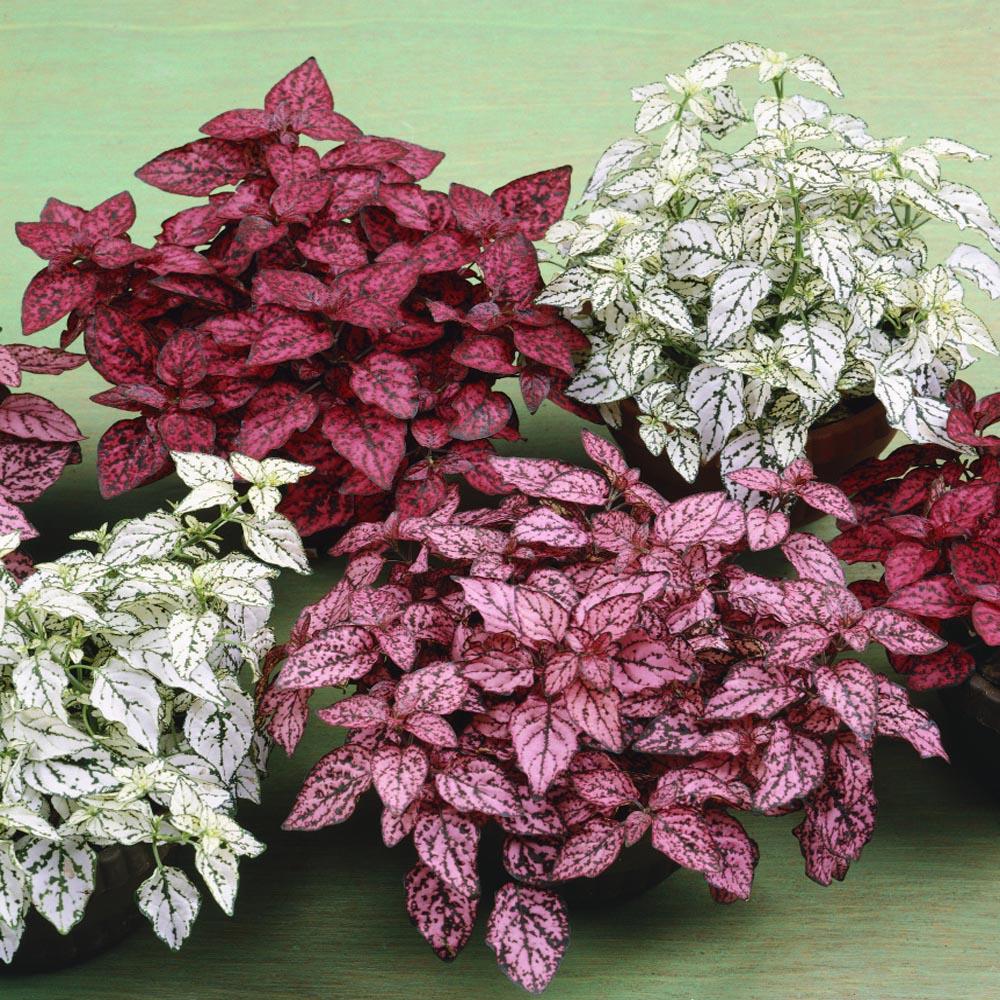
SF400 Splash Select Mix Hypoestes
This is an easy to grow houseplant, bedding plant and basket plant that requires almost no effort or maintanance. An annual foliage plant that is easy to start from seed, its leaves beautifully "splashed" with white or varying hues of pink. Quite compact, it looks terrific in shady beds and borders from spring through fall, then makes a fine winter houseplant.
Splash Select Series hypoestes seeds are a simple yet exotic grow ideal for many hot and humid gardens. Splash Select Series seeds promise 8 to 10 inch tall dwarfed leafy Polka Dot shrubs available in a famous selection of Pink, Red, Rose, White, and Mix, a perfect grow for accenting walkways, borders, fences, or patios.
Hypoestes is native to the sweltering demands of Madagascar, South Africa, and east Asia and will thrive all season in similar humid climates.
Splash Select Series hypoestes seeds are a simple yet exotic grow ideal for many hot and humid gardens. Splash Select Series seeds promise 8 to 10 inch tall dwarfed leafy Polka Dot shrubs available in a famous selection of Pink, Red, Rose, White, and Mix, a perfect grow for accenting walkways, borders, fences, or patios.
Hypoestes is native to the sweltering demands of Madagascar, South Africa, and east Asia and will thrive all season in similar humid climates.
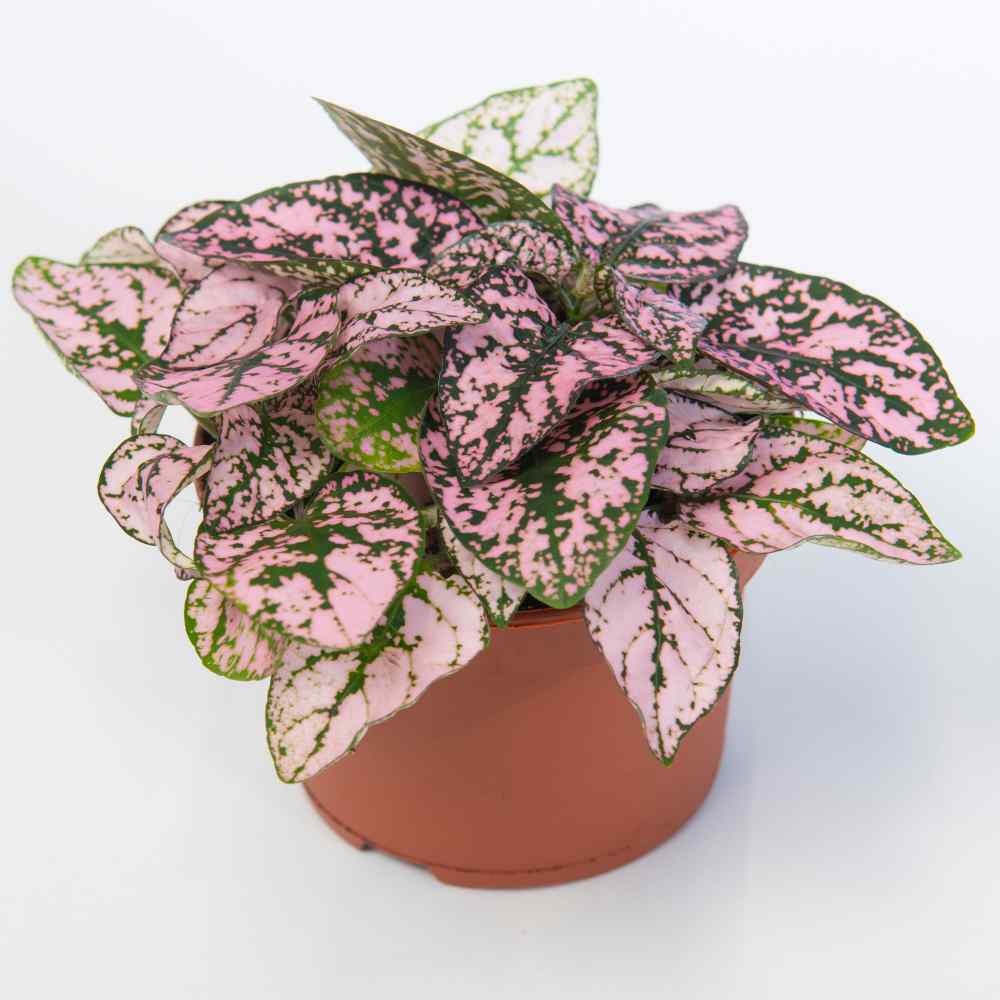
JB119 Pink Polka Dot
Grown for its variegated, attractive foliage, use this delightful plant indoors as a perennial or outdoors in the shade garden as an annual. Pink Polka Dot plant grows readily from flower seeds and will reach just 8-12 inches tall and 9 inches wide. One of the most effortless house plants or shade plants you will ever grow. An annual foliage plant (or greenhouse perennial), it springs right up from flower seed, quickly reaching its mature size. The large, pointed leaves arise from the central stem, creating a neat rosette that looks lovely in the front of the border or in containers of all sizes. The foliage is dark green very heavily splattered with light pink, so that on most leaves, only the midrib and veining remain green.
Pink Polka Dot is a great choice to mix in with other foliage plants in the shade. Its pink will sure stand out amongst other plants and give your beds a unique look. Pink Polka Dot will give months of color and enjoyment in the house too!
Pink Polka Dot is a great choice to mix in with other foliage plants in the shade. Its pink will sure stand out amongst other plants and give your beds a unique look. Pink Polka Dot will give months of color and enjoyment in the house too!
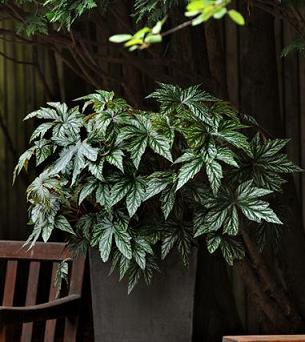
1A453 Gryphon ( Pelleted )
This wonderful foliage begonia can be used inside the home or outside in the garden.
The superb foliage of this begonia combines majestic beauty with strength and durability to make an outstanding presentation in single or combination containers.
The multiseed pellets germinate easily and will produce plants that are more tolerant to stressful conditions than Rex begonias, and size up more quickly than vegetative foliage type begonias.
Easy-care Gryphon has low water needs and produces showy displays, making it a great item for both outdoor and indoor gardens.
The superb foliage of this begonia combines majestic beauty with strength and durability to make an outstanding presentation in single or combination containers.
The multiseed pellets germinate easily and will produce plants that are more tolerant to stressful conditions than Rex begonias, and size up more quickly than vegetative foliage type begonias.
Easy-care Gryphon has low water needs and produces showy displays, making it a great item for both outdoor and indoor gardens.
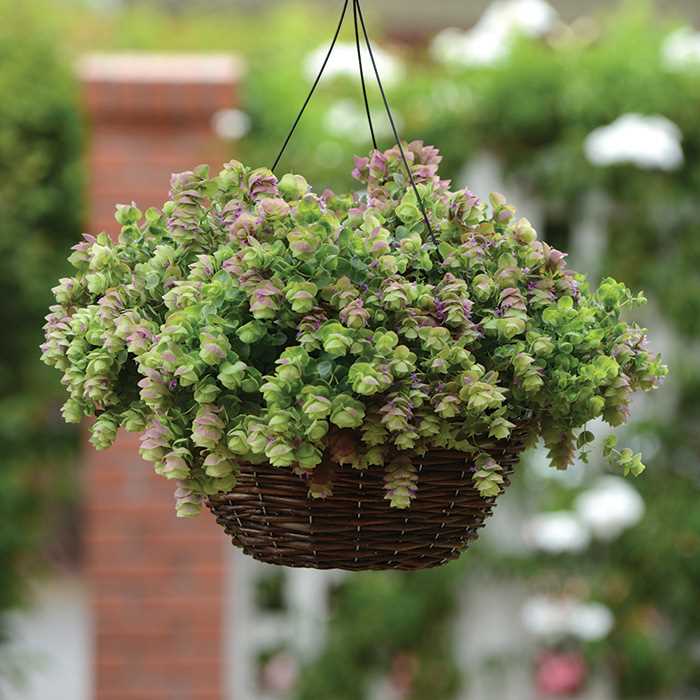
3648 Kirigami Ornamental Oregano ( Origanum x hybrida )
A non-culinary oregano with large purple-green bracts, rose flowers and light green foliage have a delicious fragrance that attracts pollinators. Higher light and cooler night temperatures accent the purple color. Mounded plants are slightly trailing with a tighter, fuller habit than standard vegetative varieties. Holds better in shipping and on the retail bench.
Perfect for hanging baskets, borders and rock gardens. Attractive when dried and used in floral arrangements. Heat and drought tolerant. Annual. Height: 8-10". Spread: 12-14".
Protection Information : US PVPAF.
Perfect for hanging baskets, borders and rock gardens. Attractive when dried and used in floral arrangements. Heat and drought tolerant. Annual. Height: 8-10". Spread: 12-14".
Protection Information : US PVPAF.
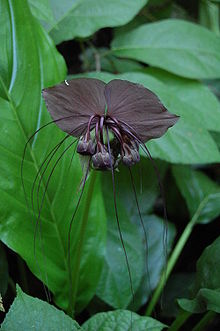
3524 Black Bat Flower ( Tacca chantrieri )
A most unusual plant introduced from parts of Malaysia, India, and East Asia, the Bat Plant will make you look twice. The main attraction of the plant is the strange, unique, purple-black flowers.
The flowers superficially resemble a bat in flight with long whiskers, and can grow up to 10 inches long. Taccas can be picky about their environmental conditions; however they grow fast and flower a lot when the conditions are just right. The Bat Plant should be planted in partial shade and in a humid and warm environment.
Soil should remain consistently moist, not allowing the plant to dry out between waterings. In winter months, when temperatures drop to 40F or lower, the Bat Plant should be moved indoors, or into a greenhouse to protect it from cold damage.
Makes a great container plant and is a real conversation piece.
The flowers superficially resemble a bat in flight with long whiskers, and can grow up to 10 inches long. Taccas can be picky about their environmental conditions; however they grow fast and flower a lot when the conditions are just right. The Bat Plant should be planted in partial shade and in a humid and warm environment.
Soil should remain consistently moist, not allowing the plant to dry out between waterings. In winter months, when temperatures drop to 40F or lower, the Bat Plant should be moved indoors, or into a greenhouse to protect it from cold damage.
Makes a great container plant and is a real conversation piece.
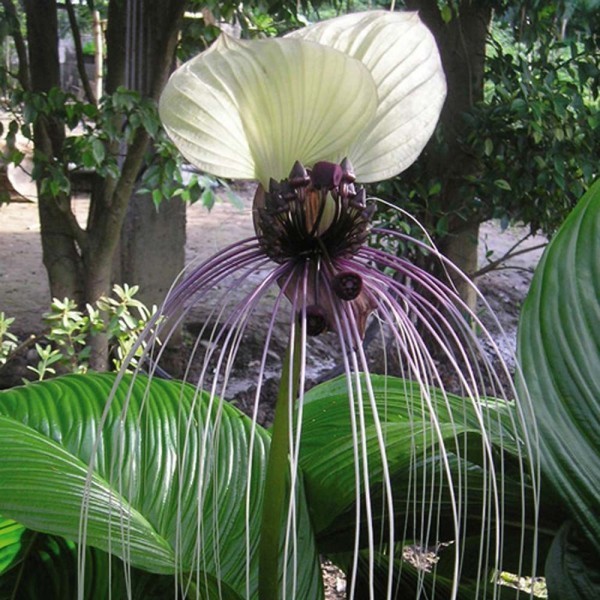
3525 White Bat Flower ( Tacca nivea )
These can be grown as a fasinating houseplant, our outside in the shade in warm climates. Brilliant white flowers to 12" width stand upright with the petals spread to the extent that they appear as a white dove - or as a bat-like form. The throat shows the coloration of faint purple- brown, and from this region protrude 10-20 prominent dark purple bracts. Flowing from this area are up to 30 thin white tentacles "whiskers". An irresistible plant for many. In the wild they grow in tropical and subtropical Asia, and in cooler climates they grow best in a shady area in a hot, humid greenhouse. Zone 10 or higher outdoors, or grow indoors in cooler climates.

3599 Giant Bat Flower ( Tacca intergifolia )
This specie is similar to Tacca Chantrieri. (The main botanical difference is in the slight variations in color and and size of the flower ).
The scape is gray, brown, and purple with flowers a blackish purple. The leaf blades are 2" long and 10" wide having a petiole to 6' with an oblong - linear shape and handsome purple veining throughout. Its filiferous "whiskers" hang to 14".
The scape is gray, brown, and purple with flowers a blackish purple. The leaf blades are 2" long and 10" wide having a petiole to 6' with an oblong - linear shape and handsome purple veining throughout. Its filiferous "whiskers" hang to 14".
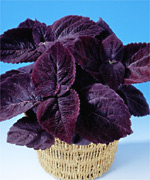
IP218 Giant Exhibition Palisandra
Originally selected as a houseplant, Giant Exhibition Palisandra is also a fine specimen in the shade garden, and is just the right size for containers.
Soft, neatly serrated burgundy-maroon leaves are 6 inches long and up to 4 inches wide.
Soft, neatly serrated burgundy-maroon leaves are 6 inches long and up to 4 inches wide.
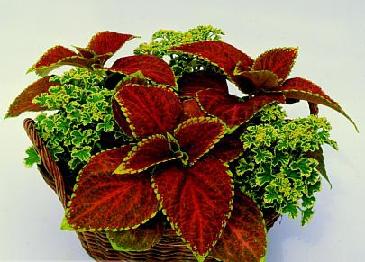
SF382 Giant Exhibition Rustic Red
This stunning Giant Exhibition Coleus is utterly distinctive, bearing large, neatly serrated, rusty-red leaves with stitched yellow edges. It's dazzling on its own or complements others beautifully when in a mixed planting, and it's suitable for indoor or outdoor growth in partial to full shade. This makes a wonderful houseplant!
These plants reach 12 to 15 inches high and wide, with leaves about 6 to 7 inches long and 4 inches wide at the base. You'll love its vigor, compact habit, and uniform color! 'Rustic Red' is a snap to grow, germinating readily from seed any time of year indoors. For bushier, fuller plants, keep the growing tips pinched.
These plants reach 12 to 15 inches high and wide, with leaves about 6 to 7 inches long and 4 inches wide at the base. You'll love its vigor, compact habit, and uniform color! 'Rustic Red' is a snap to grow, germinating readily from seed any time of year indoors. For bushier, fuller plants, keep the growing tips pinched.
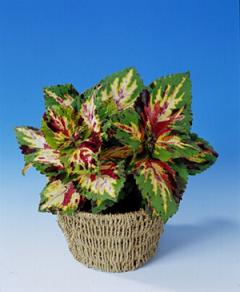
JB071 Giant Exhibition Multicolor
Green edge, white center, all splashed red, novel look for a coleus. Old fashioned, large wide leaf, striking colors, for large container or landscape. Also does well in shade.

JB266 Japanese Arailia ( Fatsia japonica )
A very versatile plant for indoor and outdoor use. Large, exotic, rich green foliage adds an exciting and bold tropical look to landscapes and patios. Great in a shaded entryway or patio, or in a sheltered spot near a water garden or dipping pool. Perfect for outdoor containers or as a houseplant. Ideal for low light, urban settings. Winter flowers are followed by black ornamental berries. Evergreen. One of the most familiar house plants around. Its huge star shaped leaves will decorate any patio or hallway. It also makes a good yard plant if given lots of light. Zones 8A-11 outside.

TWT244 Wild Spike ( Cypress alternifolius nanus )
A grasslike pot or basket foliage complement, used like Dracaena, great novelty, grows 12" tall, a perennial plant for zones 8 and higher outside, but is most commonly grown as a houseplant or patio plant. It copes well with a range of light and temperature levels, grows quickly and is easily propagated. It is used as a pond edging plant sometimes, and it will not suffer from overwatering as many houseplants do.
As an indoor pot plant they are useful for homes and conservatory, or as interior plant for commercial offices, hotels and malls, ideally in containers stood in water. Its fascinating shape makes it a great plant for landscaping, and as an accent plant or informal screen.
It is impossible to over water the Umbrella Plant as it enjoys damp and boggy conditions, so is ideal for beginners or for any seasoned gardeners remotely interested in water gardens. It can be grown in shallow water of small fish ponds as a water filtration marginal plant.
It makes an excellent tropical water garden centre piece, and can be grown in the pool as an aquatic plant, or around them in the ground as a waterside or bog garden plant. The tall bracts are also excellent when used in fresh or dried floral arrangements.
As an indoor pot plant they are useful for homes and conservatory, or as interior plant for commercial offices, hotels and malls, ideally in containers stood in water. Its fascinating shape makes it a great plant for landscaping, and as an accent plant or informal screen.
It is impossible to over water the Umbrella Plant as it enjoys damp and boggy conditions, so is ideal for beginners or for any seasoned gardeners remotely interested in water gardens. It can be grown in shallow water of small fish ponds as a water filtration marginal plant.
It makes an excellent tropical water garden centre piece, and can be grown in the pool as an aquatic plant, or around them in the ground as a waterside or bog garden plant. The tall bracts are also excellent when used in fresh or dried floral arrangements.
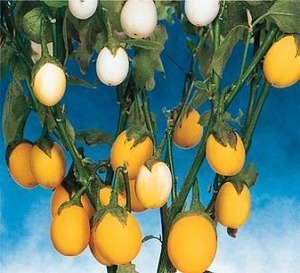
3561 Golden Eggs Ornamental Eggplant ( Solanum Melongena )
A very unique, tropical plant that will definitely give you a great conversation piece! Easy to grow as a houseplant or container plant. The variety is a popular ornamental and was one of the plantings in Thomas Jefferson's famous Monticello garden.
This annual is often called Golden Egg Tree, and in a warm environment, even indoors, it will produce purple flowers followed by egg-shaped, non-poisonous fruit. Golden Egg Tree uses include pots and containers on the patio or porch, house plants, and even as an ornamental hedge. The Ornamental Eggplant can be pruned and shaped depending on how it is being grown.
Needs a warm environment with full afternoon sun. While it can survive in cooler climates and partial sun, these plants will not produce fully ripened fruit. Ornamental Eggplant should be watered regularly, or whenever the soil is dry to the touch. It does not need to be fertilized, and is fairly disease resistant. Depending on the size of the plant and the environment where it is being grown, usually 10 - 20 egg-shaped fruits will form. The fruit are white at first and then turn yellow or even a gold color as they mature. The fruit is edible but not really tasty.
Growing Ornamental Eggplant seeds is not difficult. Sow the flower seed indoors 6 - 8 weeks before the last expected frost. Use small pots or starter trays, sterile seed starting soil and lightly cover the seed. Covering the pots with clear plastic helps to keep the humidity high. Mist the seeds often until germination occurs.
Once Ornamental Eggplant seedlings emerge, remove the plastic. Place the young seedlings in a sunny window or provide fluorescent lights. Harden the Golden Egg Tree plant off for 10 days or more, and do not transplant it outdoors until day time temperatures are in the 70's.
This annual is often called Golden Egg Tree, and in a warm environment, even indoors, it will produce purple flowers followed by egg-shaped, non-poisonous fruit. Golden Egg Tree uses include pots and containers on the patio or porch, house plants, and even as an ornamental hedge. The Ornamental Eggplant can be pruned and shaped depending on how it is being grown.
Needs a warm environment with full afternoon sun. While it can survive in cooler climates and partial sun, these plants will not produce fully ripened fruit. Ornamental Eggplant should be watered regularly, or whenever the soil is dry to the touch. It does not need to be fertilized, and is fairly disease resistant. Depending on the size of the plant and the environment where it is being grown, usually 10 - 20 egg-shaped fruits will form. The fruit are white at first and then turn yellow or even a gold color as they mature. The fruit is edible but not really tasty.
Growing Ornamental Eggplant seeds is not difficult. Sow the flower seed indoors 6 - 8 weeks before the last expected frost. Use small pots or starter trays, sterile seed starting soil and lightly cover the seed. Covering the pots with clear plastic helps to keep the humidity high. Mist the seeds often until germination occurs.
Once Ornamental Eggplant seedlings emerge, remove the plastic. Place the young seedlings in a sunny window or provide fluorescent lights. Harden the Golden Egg Tree plant off for 10 days or more, and do not transplant it outdoors until day time temperatures are in the 70's.

2258 Toothache Plant ( Spilanthes oleracea )
A must have plant for all of it's wonderful qualities. Bright, solid-yellow flower heads the shape of lemon drops, often having the common name of "Lemon Drops".
It has edible flowers, which have a spicy and citrus-like flavor, can be used as a garnish on ice cream and drinks.
Commonly known as toothache plant. Contains a natural analgesic which numbs the tongue and gums, relieving toothache pain. This numbing sensation arises from chewing either the flowers or leaves.
The full, mounding habit is perfect for containers and bed plantings. Heat tolerant.
A fast growing annual plant reaching 12-15 inches tall in about 90-100 days.
It has edible flowers, which have a spicy and citrus-like flavor, can be used as a garnish on ice cream and drinks.
Commonly known as toothache plant. Contains a natural analgesic which numbs the tongue and gums, relieving toothache pain. This numbing sensation arises from chewing either the flowers or leaves.
The full, mounding habit is perfect for containers and bed plantings. Heat tolerant.
A fast growing annual plant reaching 12-15 inches tall in about 90-100 days.
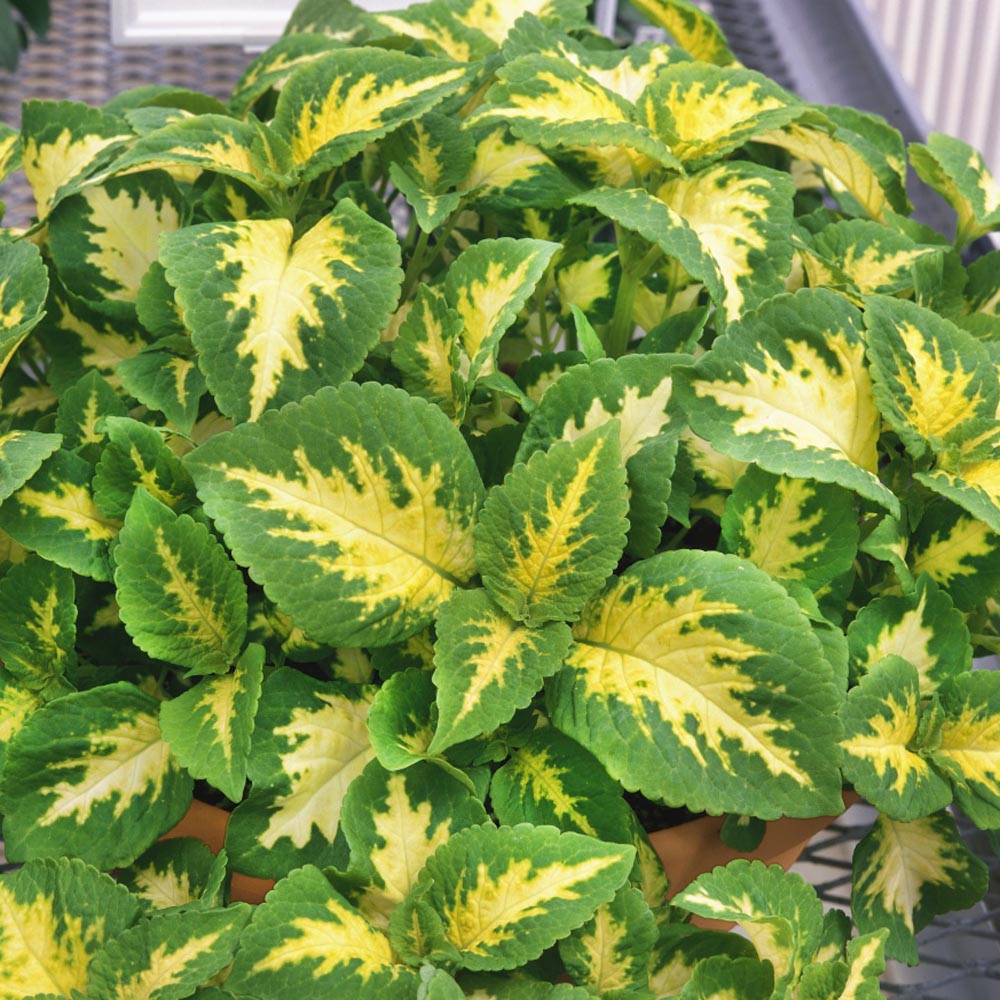
SF343 Wizard Wave
Start Coleus seeds for this exotic foliage plant that never disappoints! Wizard Jade has ivory at the center of the leaves and greens around the edges. It's a beautiful plant for shade that can be mixed in containers with other shade loving plants. Starting the flower seeds indoors in the late winter will provide you with Coleus seedlings for planting outdoors in beds or containers in the spring once frosts have passed. Or, keep a Coleus houseplant in a sunny window or under artificial lights for the exotic beauty indoors!
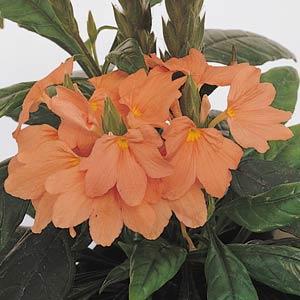
SF325 Tropic Flame ( Crossandra Infundibuliformis )
Popular as an excellent indoor pot plant during winter and summer months in the northeast. Loves heat!
Heat-tolerant continuous bloomer makes a premium landscape plant in tropical and semi-tropical areas from Florida to southern Asia. Transplant to finish: South, 10 to 11 weeks. Grows 10 inches tall and spreades 8-10 inches.
Heat-tolerant continuous bloomer makes a premium landscape plant in tropical and semi-tropical areas from Florida to southern Asia. Transplant to finish: South, 10 to 11 weeks. Grows 10 inches tall and spreades 8-10 inches.
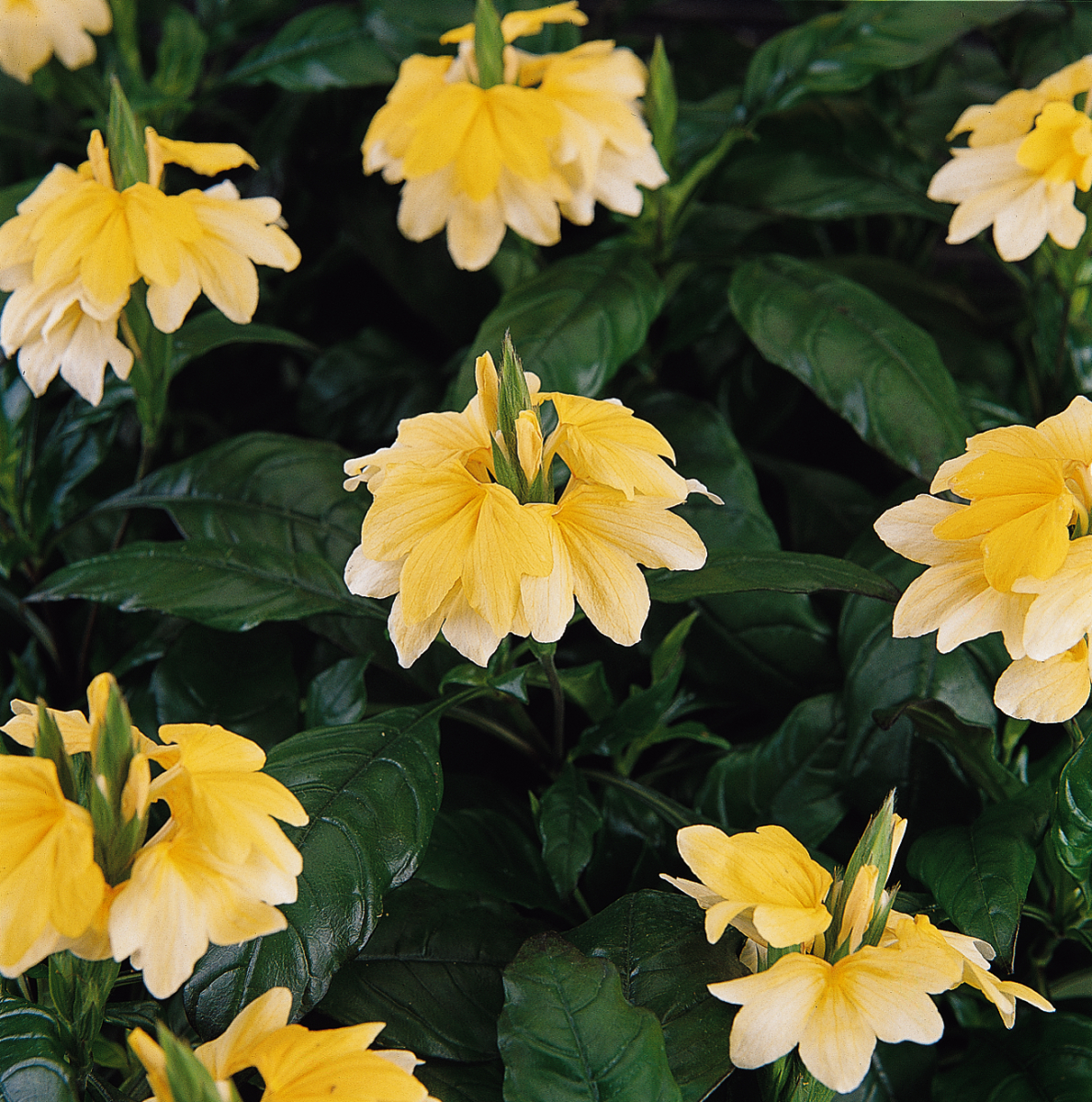
IP367 Yellow Splash ( Crossandra Infundibuliformis )
Enjoy this topical, flowering plant indoors! Very few plants will provide color for a long period of time indoors in bright indirect light, but Crossandra, also called Firecracker Flower, will light up the indoors. With it's glossy, dark green leaves and clusters of yellow blooms, the Firecracker plant is also great for those partial shade plantings outdoors along with impatiens and coleus.
Crossandra care includes regular watering as the plant does not do well if allowed to dry out. If grown in an arid climate or indoors, regular mistings are also beneficial. Soil should be well-draining and fertilizers can be applied through out the growing season. Removing faded blooms will encourage continued blooming. The flower seeds can be started indoors and should be left uncovered. The Firecracker plant can bloom in just 4 months after starting the flower seeds.
Crossandra care includes regular watering as the plant does not do well if allowed to dry out. If grown in an arid climate or indoors, regular mistings are also beneficial. Soil should be well-draining and fertilizers can be applied through out the growing season. Removing faded blooms will encourage continued blooming. The flower seeds can be started indoors and should be left uncovered. The Firecracker plant can bloom in just 4 months after starting the flower seeds.
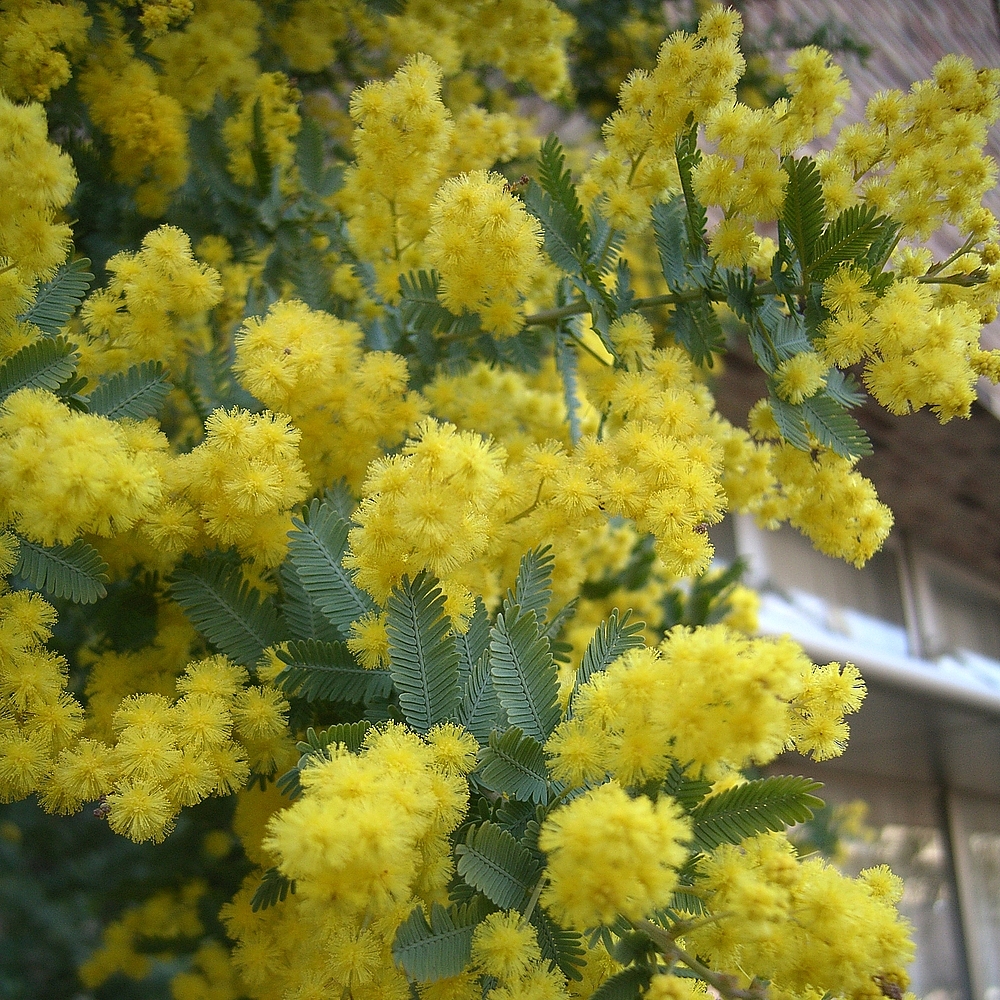
Image: By Taken byfir0002 | flagstaffotos.com.auCanon 20D + Tamron 28-75mm f/2.8 - Own work, GFDL 1.2, Link
D1164 Golden Mimosa ( Acacia baileyana )
Australia. Small graceful tree well adapted to growing inside.
Has such a profusion of beautiful flowers that they seem to
cover the entire plant. Cold hardy to 18 degrees outside.
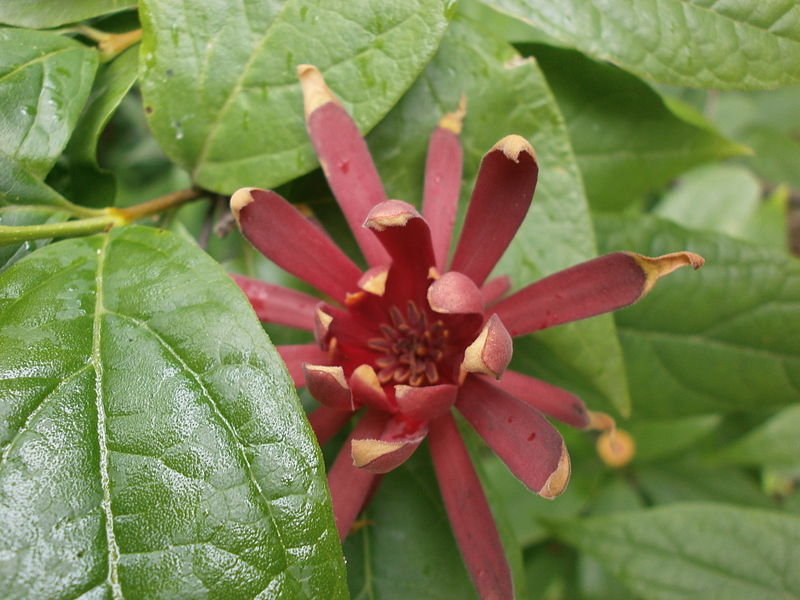
Image: By Yera [CC BY-SA 3.0], from Wikimedia Commons
D5165 Sweet Shade ( Calycanthus floridus )
A fast growing shrub with very fragrant reddish brown flowers.
Calycanthus floridus thrives in a wide range of light conditions, from full sun to full shade, making it a good candidate for a houseplant.
It grows between 4 and 7 feet tall outside, but will grow much smaller in containers inside, and exudes a spicy fragrance from its brown flowers, particularly in the evening. The fragrance of a mature plant will fill your home. The leaves are a dark, rich green and are fragrant when they are crushed.
The bark of the plant can be used as cinnamon substitute.
Hardy for zones 5-8b.
It grows between 4 and 7 feet tall outside, but will grow much smaller in containers inside, and exudes a spicy fragrance from its brown flowers, particularly in the evening. The fragrance of a mature plant will fill your home. The leaves are a dark, rich green and are fragrant when they are crushed.
The bark of the plant can be used as cinnamon substitute.
Hardy for zones 5-8b.
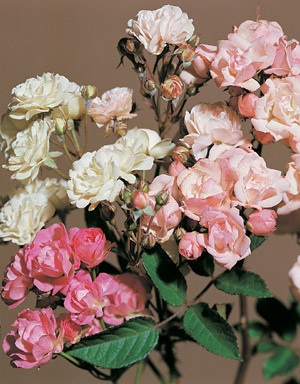
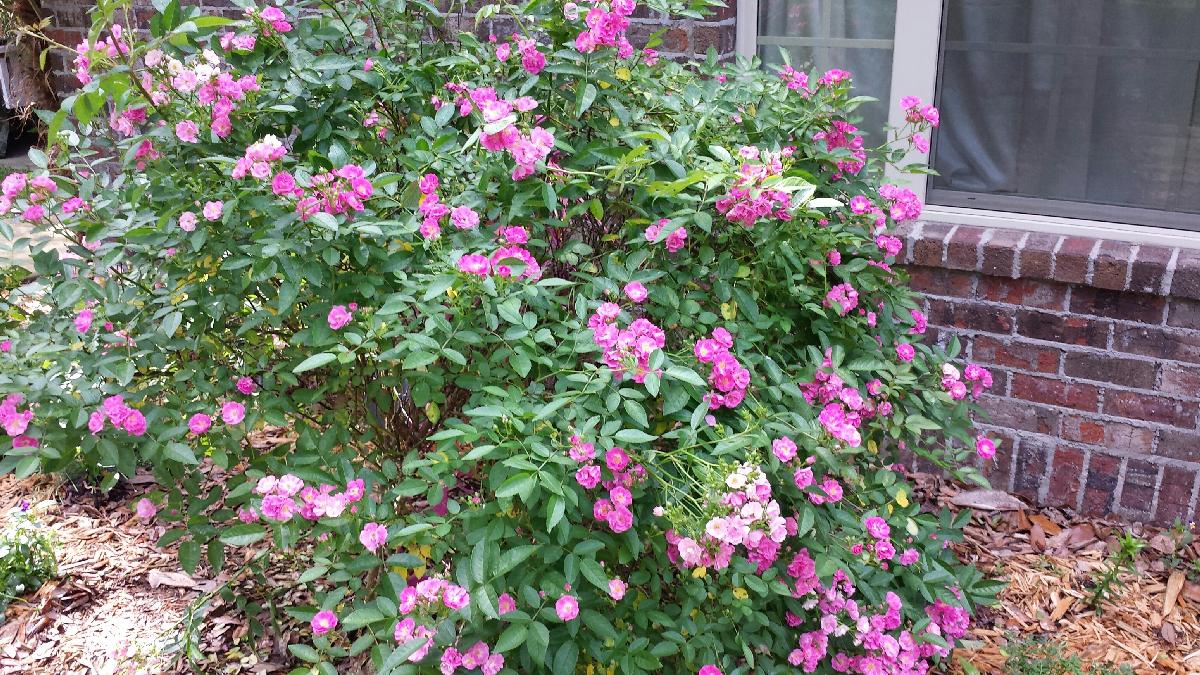
BM02 Angel Wings Miniature Roses ( Rosa chinensis )
Looking for the perfect plant for your home, patio or garden?These are probably the ones. Blooming in as little as 3 months from from the time they germinate, we have had these bloom in 4" pots before we could transplant them.
Blooming stronger and more prolifically each following year, this variety produces a constant supply of sweetly scented double and semi-double roses about 2" in size in lovely shades of rose, pink and white.
Growing to about 12-18 inches high in containers and baskets (they can eventually get larger outside in gardens as you can see in the photo, but can be sheared to any size you want ), they make excellent edging plants, potted plants or even take them indoors as lovely houseplants that will flower year round in a bright sunny window. Slow to germinate, about 3-4 months on average, this can be reduced considerably by cold stratifying, but seeds can be started any time of the year and provide good germination rate. Perennial zones 4 and higher.
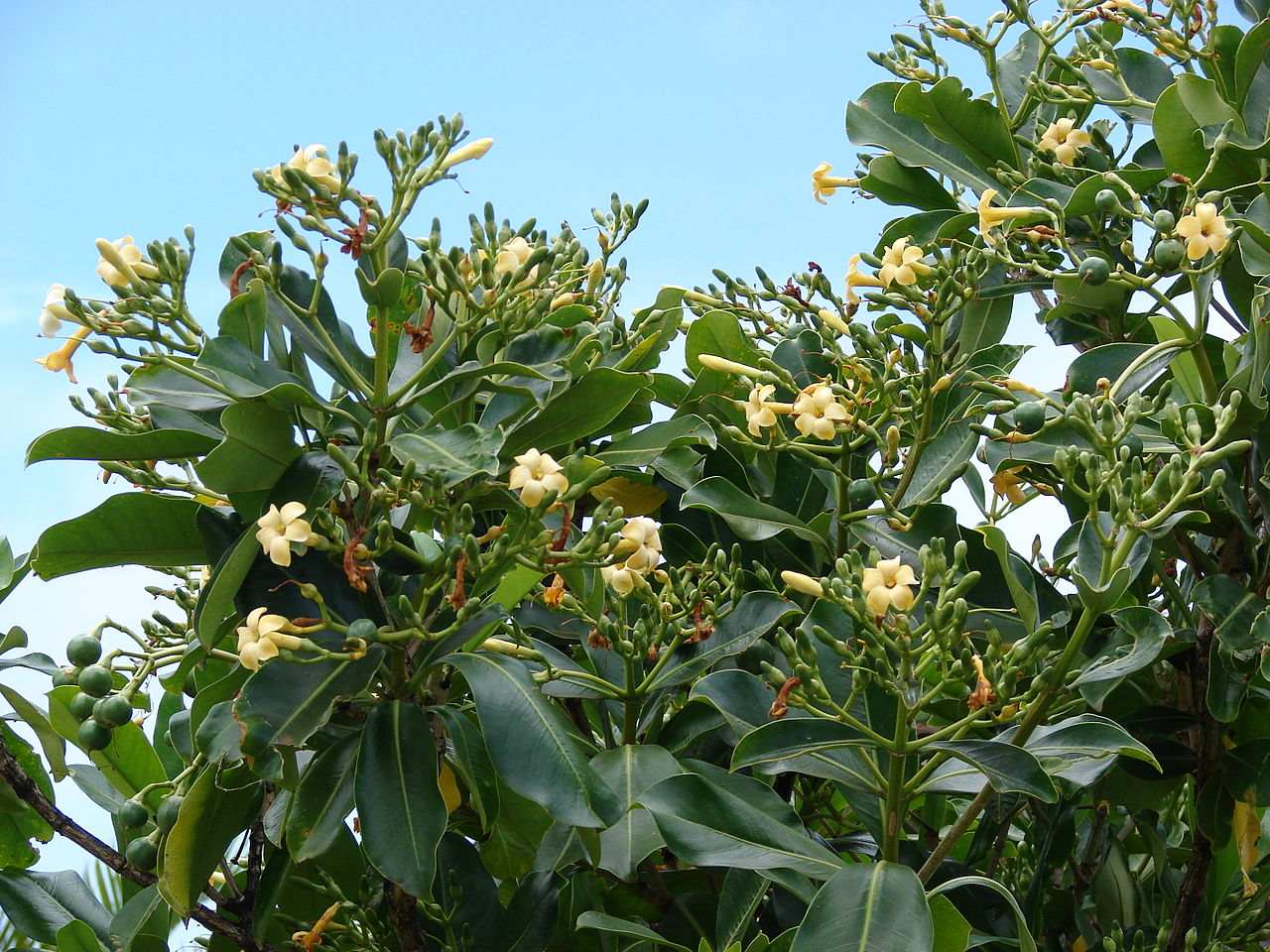
IP295 Perfume Tree ( Fagraea berteriana )
A large tropical plant outside in warm zones, can be container grown inside. Terminal clusters of white flowers that age to orange are laden with a heavy yet pleasing perfumed scent. Fagraeas are often used in leis in Hawaii; the fragrance will hold even after the blooms have dried. Give this slow grower plenty of warmth and direct sunlight and it will be a steady grower and reliable bloomer. Grow in a porous potting mix for its semi-epiphytic nature. In the north, blooms from spring to fall. In the south it is a year-round bloomer.
It is a popular ornamental in tropical Asia as it is adaptable and can be cut into nearly any shape. It is also popular for its very hard, high quality wood.
Fagraea is one of the most fragrant plants to grow in containers. Plants flower intermittently throughout the years with blooms arising on the flush of the new growth. As they are semiepiphytic, they do best in an open well-drained potting mix and be sure there is some dryness to the mix between waterings. They can be grown in sphagnum moss if moisture is checked regularly. Very small seeds.
Zone 10 and higher outside, container grown in cooler zones.
It is a popular ornamental in tropical Asia as it is adaptable and can be cut into nearly any shape. It is also popular for its very hard, high quality wood.
Fagraea is one of the most fragrant plants to grow in containers. Plants flower intermittently throughout the years with blooms arising on the flush of the new growth. As they are semiepiphytic, they do best in an open well-drained potting mix and be sure there is some dryness to the mix between waterings. They can be grown in sphagnum moss if moisture is checked regularly. Very small seeds.
Zone 10 and higher outside, container grown in cooler zones.
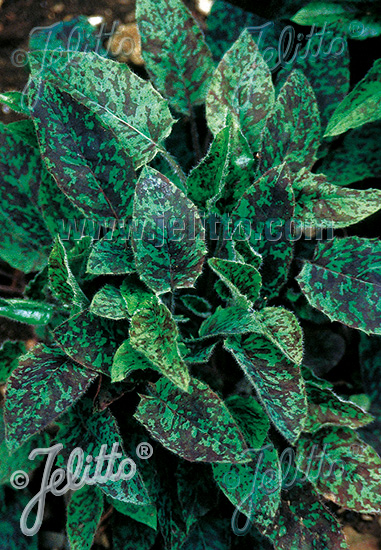
IP307 Leopard ( Hieracium maculatum )
Also known as Chocolate Dip Plant and Spotted Hawkweed. This is a very ornamental pernnial bee plant that requires very little care. Dense rosette leaves, bluish-green with red-brown marbeling, gold flowers, very decorative, growing about 10" tall and forming clumps. Excellent garden or pot plant that is a favorite of bees.
A perennial for zones 4-8.
A perennial for zones 4-8.
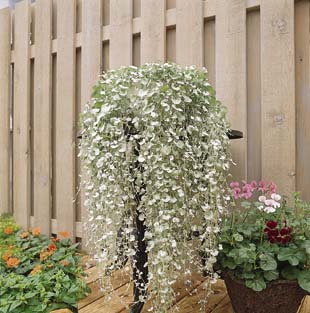
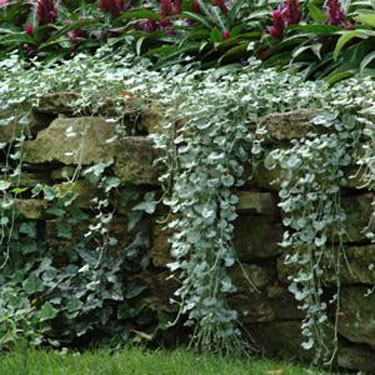
3650 Silver Falls ( Dichondra Argentea )
If you like the dark green Emerald Falls Dichondra, then you will also love the silvery foliage of Silver Falls Dichondra. It is a wonderful pick for hanging baskets or use as a stunning low growing ground cover to use around the other plants. You will love how the contrasting foliages set each other off! Dichondra is commonly called Ponyfoot, and this silver Ponyfoot is a must-have for the summer display.Silver Falls is characterized by silvery leaves, glistening silver stems, and a cascading habit that can spread up to 5 feet. Easy and fast growing from seeds, this Dichondra plant is simply one of the showiest accents around for all your containers and bare garden spots. The 3/4 - 1 inch leaves have a thick, super-soft texture and neat fan shape. Just like Emerald Falls, this adorable foliage plant needs no pinching.
Quicker than you can say Silver Falls, this cascading beauty will be 3 to 5 feet long, but only growing 3 - 5 inches tall. It is also very heat and drought tolerant making it the perfect plant for sunny locations. Silver Falls recovers quickly even if wilted, and looks fresh all season long.
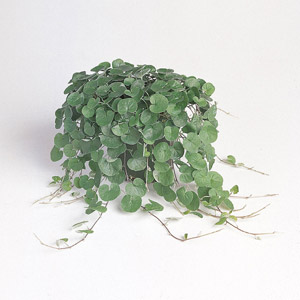
TPF231 Emerald Falls MSP ( Dichondra repens )
Annual. Vigorous and easy to grow, this Dichondra boasts thick, super-soft deep green leaves (about an inch wide) arising profusely on very well-branched plants that need no pinching. Emerald Beauty will cascade about 3 feet from your baskets, windowboxes, or other containers, but it will also form a nicely domed shape that fills the available space beautifully!
Very heat- and drought-tolerant, it recovers quickly even if wilted, and looks fresh all season long. Try it in a large container behind super-cascading Silver Falls, or among trailing flowering plants from Periwinkle to Sweet Pea.
Emerald Falls thrives in full sun and well-drained soil. Start the seeds indoors in late winter (about 6 to 8 weeks before last anticipated frost) and then set out when the weather warms up in spring.
Multiseed Pellets ( each pellet contains 6-8 seeds ).
Very heat- and drought-tolerant, it recovers quickly even if wilted, and looks fresh all season long. Try it in a large container behind super-cascading Silver Falls, or among trailing flowering plants from Periwinkle to Sweet Pea.
Emerald Falls thrives in full sun and well-drained soil. Start the seeds indoors in late winter (about 6 to 8 weeks before last anticipated frost) and then set out when the weather warms up in spring.
Multiseed Pellets ( each pellet contains 6-8 seeds ).
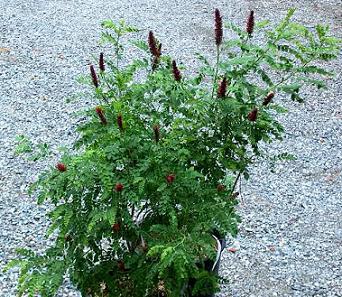
3352 Fragrant False Indigo ( Amorpha nana )
A compact erect shrub with green foliage. Leaves are alternate, odd-pinnate up to 1-4 inches long. The fragrant pink flowers appear in May through July.
The pink flowers have a delightful honey fragrance. Excellent container plant for use as a fragrant houseplant, and does well outside in almost all soils, drought tolerant.
Perennial. Hardy outside to zone 3.
The pink flowers have a delightful honey fragrance. Excellent container plant for use as a fragrant houseplant, and does well outside in almost all soils, drought tolerant.
Perennial. Hardy outside to zone 3.
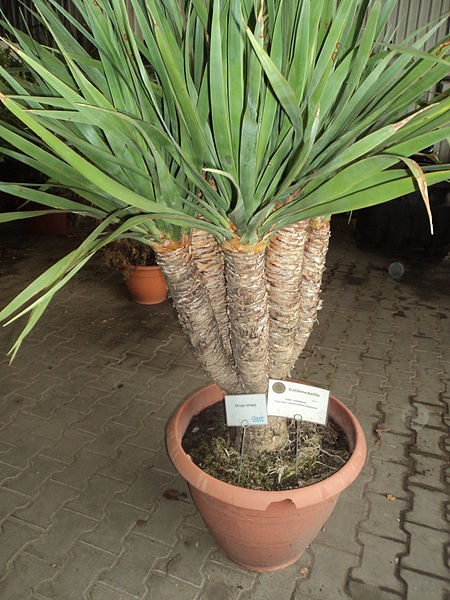
SO397 Dragon Tree ( Dracaena draco )
A very attractive and interesting succulent tree that is commonly used as a house plant, and will remain small if grown in containers inside, but if planted in the ground in a near frost free climate it will grow to a massive and broad tree that is 25 feet tall and as wide and, with great age, even larger.
The terminal ends of the thick branches hold clusters of 2 foot long by 1 1/2 inch wide pliable sword-shaped blue-green leaves. In early summer appear the greenish-white flowers that are followed by orange berries. This plant remains unbranched until it flowers or is otherwise damaged and then produces two large heavy branches on either side of the inflorescence.
When the bark is cut or bruised the sap flows as a reddish colored resin. This resin, one of the sources of a substance known as Dragon's blood can be used to stain wood. Plant in full sun or part shade. Water infrequently and deeply, do not allow the root zone to remain wet as this is the easiest way to kill this plant. It is hardy to about 20-25°F
Not really a tree although it will reach up to 60 ft. outside. It is most often raised inside in tubs. Has large sword like leaves in a rosette shape. A great patio plant. Very carefree plant.
The terminal ends of the thick branches hold clusters of 2 foot long by 1 1/2 inch wide pliable sword-shaped blue-green leaves. In early summer appear the greenish-white flowers that are followed by orange berries. This plant remains unbranched until it flowers or is otherwise damaged and then produces two large heavy branches on either side of the inflorescence.
When the bark is cut or bruised the sap flows as a reddish colored resin. This resin, one of the sources of a substance known as Dragon's blood can be used to stain wood. Plant in full sun or part shade. Water infrequently and deeply, do not allow the root zone to remain wet as this is the easiest way to kill this plant. It is hardy to about 20-25°F
Not really a tree although it will reach up to 60 ft. outside. It is most often raised inside in tubs. Has large sword like leaves in a rosette shape. A great patio plant. Very carefree plant.
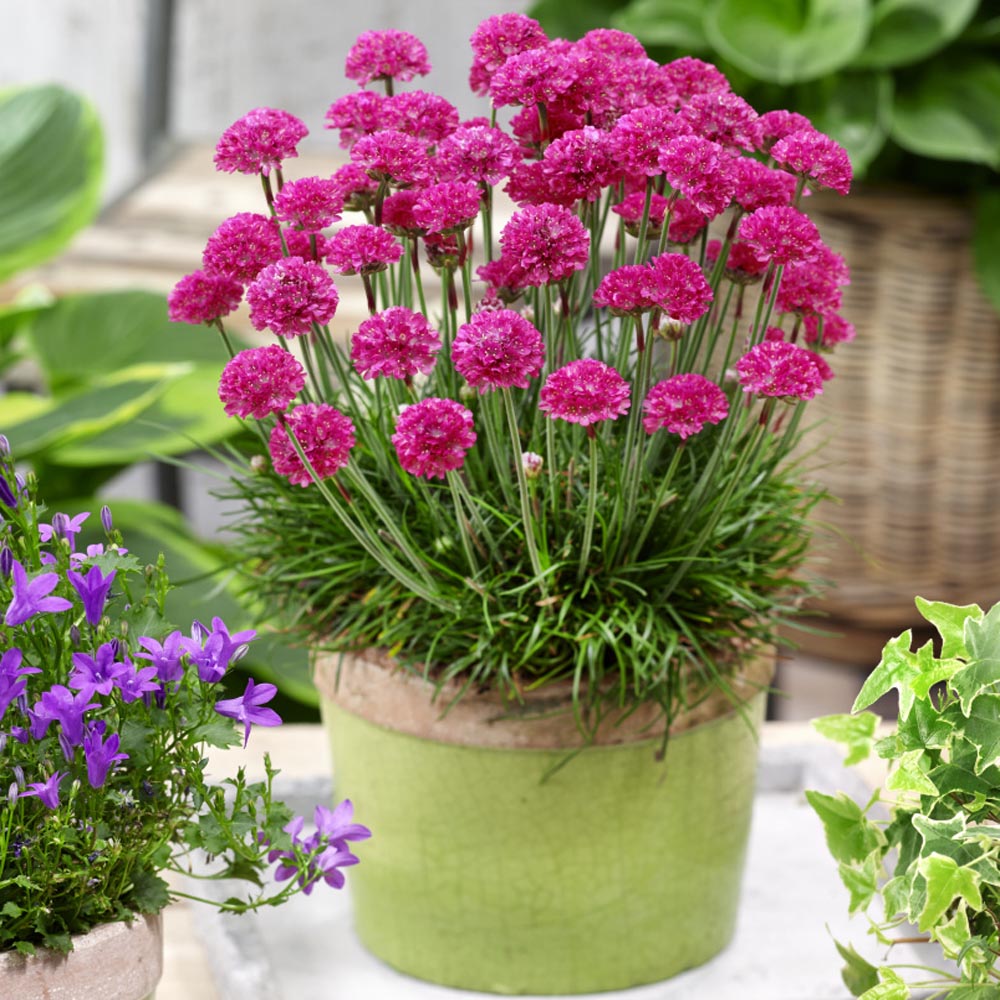
JB164 Sea Pink ( Armeria Maritima Splendens )
An outside flowerbed perennial that also makes a great houseplant. Also known as Sea Thrift. Sea has pink flower clusters that resemble little pom-poms. The foliage is grass-like and forms low clumps. Armeria is known as a low-maintenance perennial and is also commonly called Sea Pink.
An excellent cutflower. Attracts bees and butterflies. As an ornamental plant, Sea Thrift has already been used in our gardens for a long time. Because of the habitat requirements, it is well-suitable for rockeries, nature-near gardens, heather gardens or beach gardens. If it feels good, it sows itself and appears in many locations.
Armeria Maritima is tolerant of dry, poor and even salty soils. Armeria Sea Pink grows readily from flower seed, and does well in full sun and well-drained soil. It is very drought tolerant and an excellent choice for rock gardens.
Height: 8-10 inches. USDA Zones: 3 - 9
An excellent cutflower. Attracts bees and butterflies. As an ornamental plant, Sea Thrift has already been used in our gardens for a long time. Because of the habitat requirements, it is well-suitable for rockeries, nature-near gardens, heather gardens or beach gardens. If it feels good, it sows itself and appears in many locations.
Armeria Maritima is tolerant of dry, poor and even salty soils. Armeria Sea Pink grows readily from flower seed, and does well in full sun and well-drained soil. It is very drought tolerant and an excellent choice for rock gardens.
Height: 8-10 inches. USDA Zones: 3 - 9

2045 Foxtail Fern ( Asparagus Meyeri )
Starting these plants from seeds is an easy way to add many of these unique plants to your landscape! Asparagus Meyeri is an evergreen arching perennial that has feathery, needle-like, stems and is grown from flower seeds.
This Asparagus Fern's growth habit is very dense and it produces tail-like fronds for a fluffy look that resembles a foxtail so many people call it Foxtail Fern. In the summer the plant has small white flowers that are followed by bright red berries. Asparagus Fern plants can grow 2 feet in height and to a width of 3 to 4 feet.
A delightful, fast growing houseplant with dense, upright to slightly arching foxtail-like fronds 12-18" long, often used in pots or outside in warm gardens. A wonderful acccent plant that is quite hardy.
This Asparagus Fern's growth habit is very dense and it produces tail-like fronds for a fluffy look that resembles a foxtail so many people call it Foxtail Fern. In the summer the plant has small white flowers that are followed by bright red berries. Asparagus Fern plants can grow 2 feet in height and to a width of 3 to 4 feet.
A delightful, fast growing houseplant with dense, upright to slightly arching foxtail-like fronds 12-18" long, often used in pots or outside in warm gardens. A wonderful acccent plant that is quite hardy.
D4535 Asparagus Fern ( Sprengeri )
The Asparagus Fern features trailing bright glossy foliage. When planted in containers, the unique feathery foliage makes a lovely complement to flowers. It makes an excellent house plant and works well in hanging baskets. Asparagus Fern is a slightly woody evergreen plant with upright or trailing branches. It is easily established from flower seed, and it is easy to grow and drought-tolerant. This fern-like perennial develops into a fast-growing, sprawling ground cover, or a nice-sized houseplant that requires minimal care.
Grows 24 inches in height and 24 - 36 inches wide in full to part sun. Grown in some shade, the foliage will maintain a deeper green color. It likes moist but well-drained soil.
Asparagus Fern produces a flower. The flowering time lasts for roughly two weeks during the summer. Bright red berries follow the inconspicuous, fragrant white or pale pink flowers. Birds are highly attracted to the fruit and aid in the dispersal of the flower seed. Sow Asparagus Fern seeds in potting mix indoors. Transplant outdoors after danger of frost.
Grows 24 inches in height and 24 - 36 inches wide in full to part sun. Grown in some shade, the foliage will maintain a deeper green color. It likes moist but well-drained soil.
Asparagus Fern produces a flower. The flowering time lasts for roughly two weeks during the summer. Bright red berries follow the inconspicuous, fragrant white or pale pink flowers. Birds are highly attracted to the fruit and aid in the dispersal of the flower seed. Sow Asparagus Fern seeds in potting mix indoors. Transplant outdoors after danger of frost.

2996 Asparagus Plumosa
Fine lacy leaves, for baskets or cutting. Makes a wonderful houseplant, very easy to grow. Reaches about 18" tall in pots. One of the fastest-growing least demanding houseplants. Asparagus ferns are not ferns at all, they belong to the asparagus family. Grown for the graceful feathery-like, fern-like foliage; sprays utilized in floral arrangements.
Asparagus plumosa ferns are also called lace fern, climbing asparagus, asparagus grass, or ferny asparagus. Perfect for all kinds of containers, including window boxes, hanging baskets and combination planters.
Asparagus plumosa ferns are also called lace fern, climbing asparagus, asparagus grass, or ferny asparagus. Perfect for all kinds of containers, including window boxes, hanging baskets and combination planters.
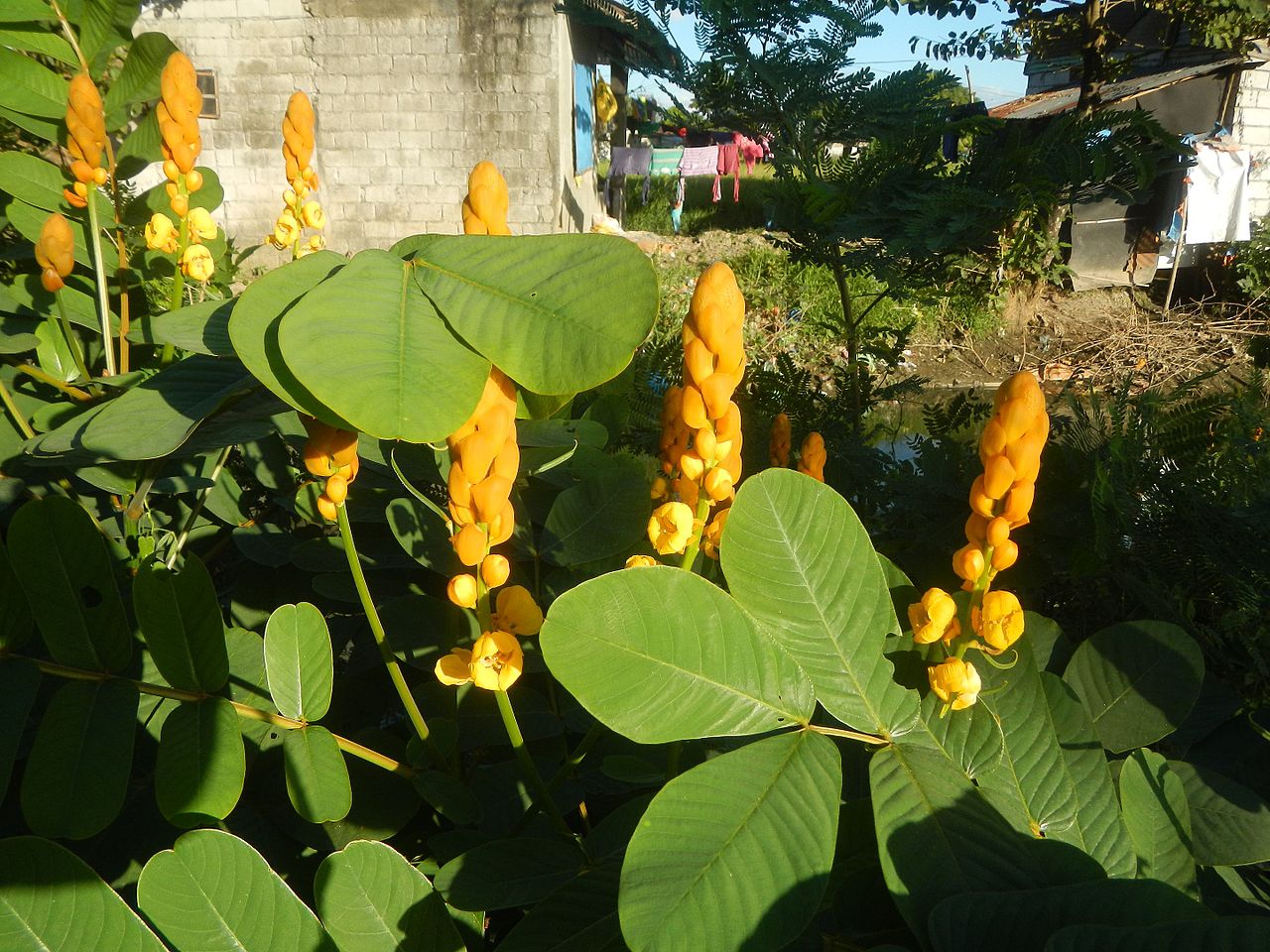
SO525 Candlebush Cassia ( Cassia alata )
A tropical plant that is easily grown indoors. Has handsome
foliage and candle like spikes of yellow flowers. A must for
every houseplant lover.
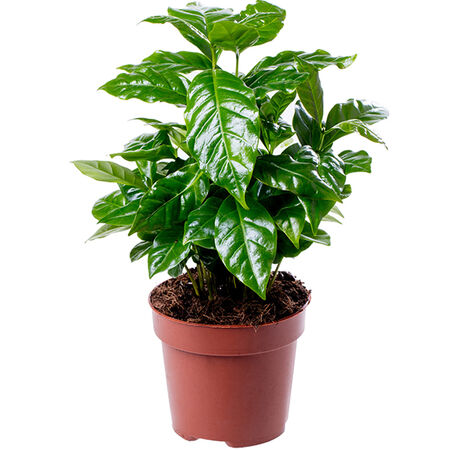
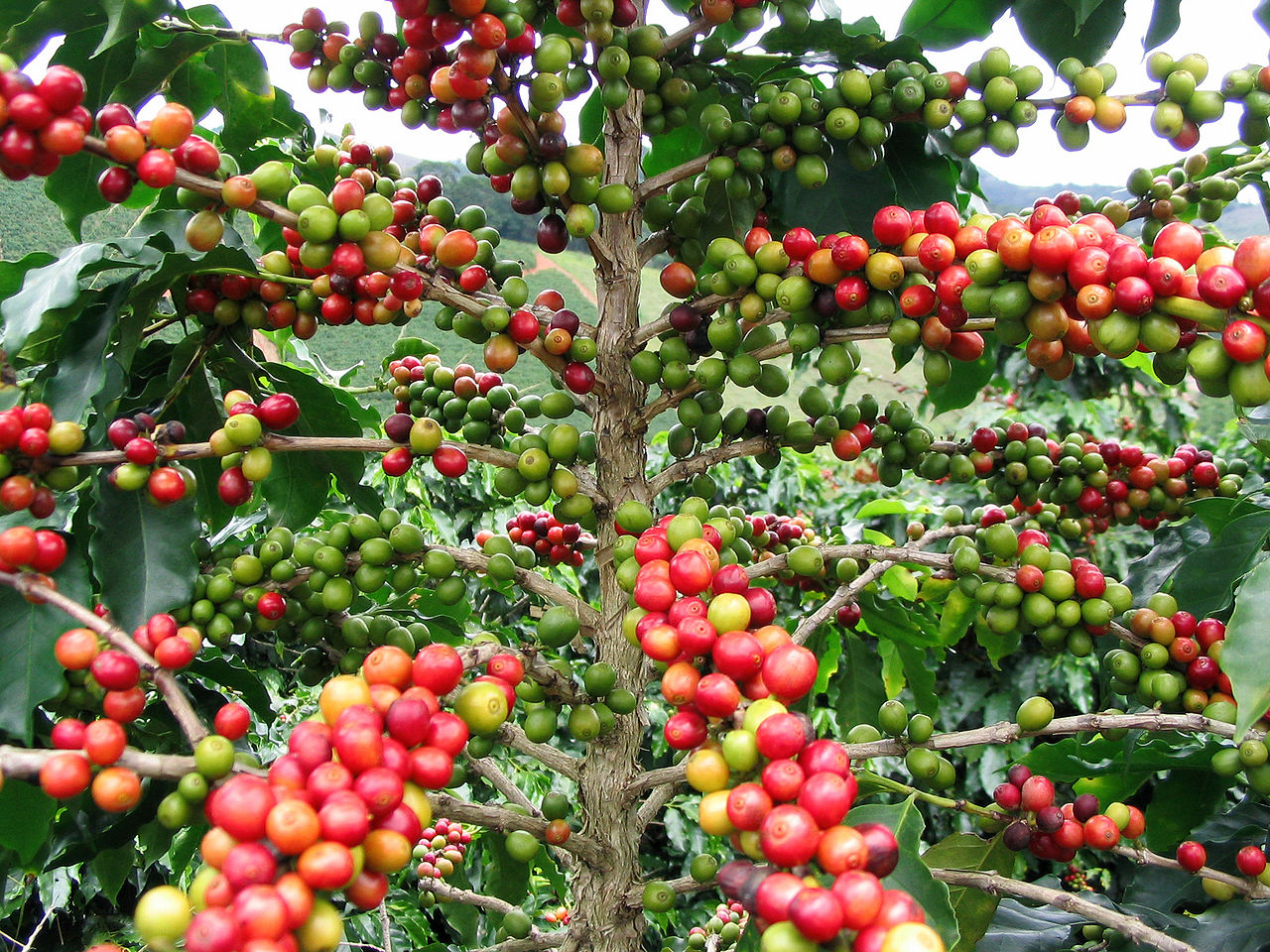
D4503 Coffee Plant ( Coffea Arabica )
Coffee can be grown outdoors in some parts of the US, but is often grown in pots. The world's most important trade crop also makes a wonderful house plant. Click here for info on growing your coffee plant inside. The plants have dark shiny-green leaves and whitefragrant flowers. A very ornamental plant. Very unique.
Considered to be among the easiest and hardiest of houseplants, coffee plant is great for both experienced and beginner gardeners. Not only is coffee plant care easy, but the plant itself is lovely and makes a wonderful addition to the home. Coffee plants prefer bright, but indirect, light. This means that they should be placed near a window but not directly in the window itself. They also cannot take temperatures below freezing and will not do well in temperatures that stay consistently below 65 degrees. Keep them away from drafts in the winter. When growing coffee plants, the soil needs to stay moist, but not soaking wet.
Also, make sure that both the soil and the pot your coffee plant is growing in has good drainage. The humidity around the plant will need to stay high as well. Setting your coffee plant on a water-filled pebble tray will help with humidity. Like many houseplants, a coffee plant will need less water in the winter than in the summer.
Plant coffee plants in a rich, peat-based potting soil with excellent drainage. Coffee plants prefer acidic soil, so if your plant is not thriving add organic matter such as sphagnum peat moss to increase soil pH. Coffee plants can grow in soil with a pH range of 4 to 7 but the ideal pH range is closer to 6 to 6.5.
Considered to be among the easiest and hardiest of houseplants, coffee plant is great for both experienced and beginner gardeners. Not only is coffee plant care easy, but the plant itself is lovely and makes a wonderful addition to the home. Coffee plants prefer bright, but indirect, light. This means that they should be placed near a window but not directly in the window itself. They also cannot take temperatures below freezing and will not do well in temperatures that stay consistently below 65 degrees. Keep them away from drafts in the winter. When growing coffee plants, the soil needs to stay moist, but not soaking wet.
Also, make sure that both the soil and the pot your coffee plant is growing in has good drainage. The humidity around the plant will need to stay high as well. Setting your coffee plant on a water-filled pebble tray will help with humidity. Like many houseplants, a coffee plant will need less water in the winter than in the summer.
Plant coffee plants in a rich, peat-based potting soil with excellent drainage. Coffee plants prefer acidic soil, so if your plant is not thriving add organic matter such as sphagnum peat moss to increase soil pH. Coffee plants can grow in soil with a pH range of 4 to 7 but the ideal pH range is closer to 6 to 6.5.
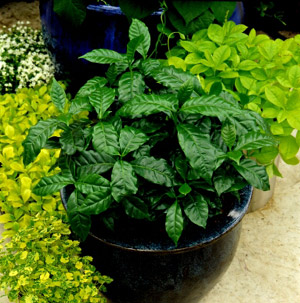
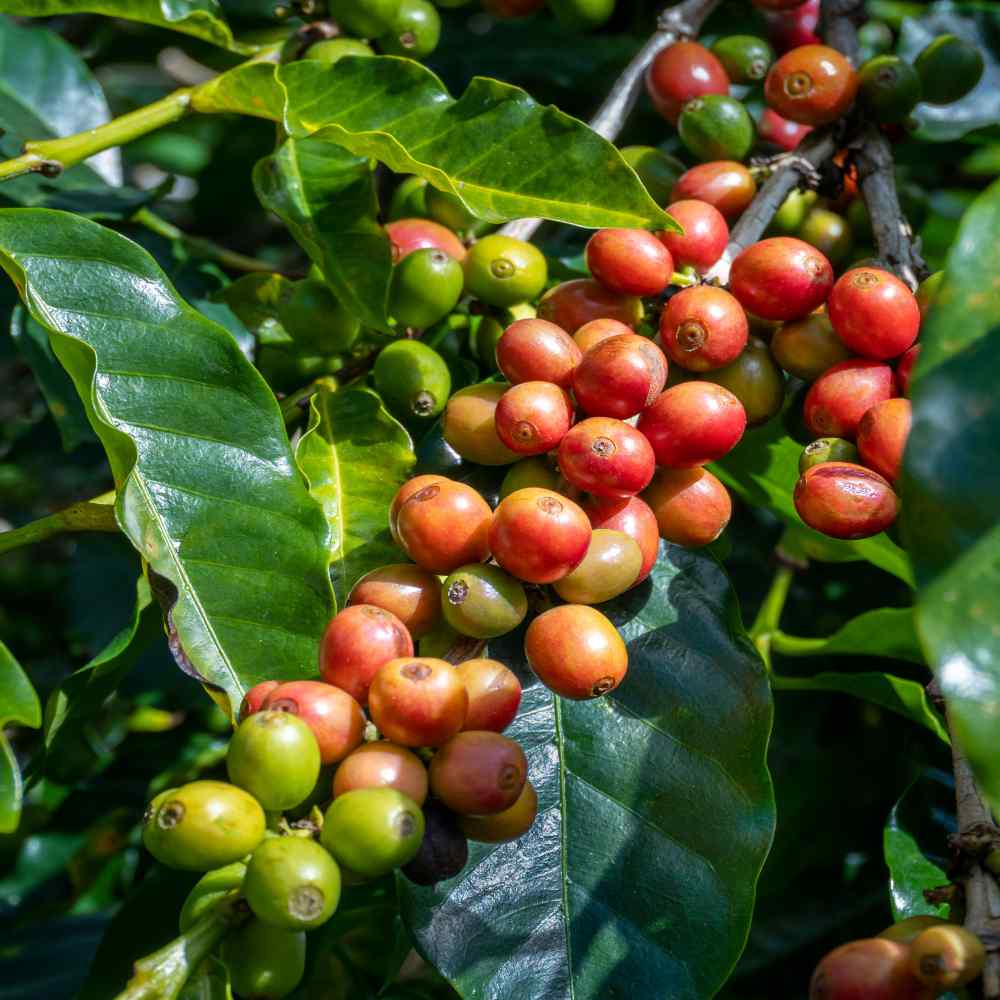
TRZ140 Arabica Nana Coffee ( Coffee Arabica Nana )
Wouldn't it be nice to grow your own coffee house plant from coffee seeds? Coffea arabica nana is a dwarf bush with beans that contain caffeine, theophylline and theobromine. The beans are dried, roasted and ground, and then extracted with water to produce coffee. Coffea arabica is a species of coffee bush that produces arabica coffee, accounting for the majority of the coffee consumed in the world. This species of bush is the oldest known bush to be cultivated for coffee production. Until the beginning of the 20th century, it was virtually the only type of tree from which coffee was harvested commercially.
The Coffea Arabica plant produces star-shaped, sweetly scented white flowers. These flowers are followed by green fruits which change to red then to almost black as they ripen, a process that takes several months. Inside each ripened fruit are 2 seeds (or beans) that when properly roasted can be ground and made into coffee.
Growing coffee plants indoors from Coffea Arabica seeds is easy. They are vigorous growers and are long-lived. Coffea Arabica plants are very attractive. Just don't expect them to offer that morning cup of joe as the coffee plants as well as coffee seeds take some patience, and it could take a few years before you see many fruits on it.
The Coffee plant is usually about 1 foot in height at the time of purchase from a nursery, but can reach a height of about 5 feet, growing 12 inches per year. If a smaller plant is preferred, the dwarf version, Coffea arabica nana, which is what we offer, remains much smaller and grows at a slower rate normally only reaching about 18" tall. Can be grown in bright light indoors, outside in zone 10 and higher.
The Coffea Arabica plant produces star-shaped, sweetly scented white flowers. These flowers are followed by green fruits which change to red then to almost black as they ripen, a process that takes several months. Inside each ripened fruit are 2 seeds (or beans) that when properly roasted can be ground and made into coffee.
Growing coffee plants indoors from Coffea Arabica seeds is easy. They are vigorous growers and are long-lived. Coffea Arabica plants are very attractive. Just don't expect them to offer that morning cup of joe as the coffee plants as well as coffee seeds take some patience, and it could take a few years before you see many fruits on it.
The Coffee plant is usually about 1 foot in height at the time of purchase from a nursery, but can reach a height of about 5 feet, growing 12 inches per year. If a smaller plant is preferred, the dwarf version, Coffea arabica nana, which is what we offer, remains much smaller and grows at a slower rate normally only reaching about 18" tall. Can be grown in bright light indoors, outside in zone 10 and higher.
D2228 Common Olive ( Olea europaea )
A fun plant that can be grown indoors. One reason people are taking to olive trees as houseplants is that caring for olive trees inside is easy. These trees tolerate dry air and dry soil too, making it an easy-care houseplant. And the trees are attractive too. The branches are covered with narrow, grey-green leaves that have furry undersides. Also does a great job at purifying indoor air.
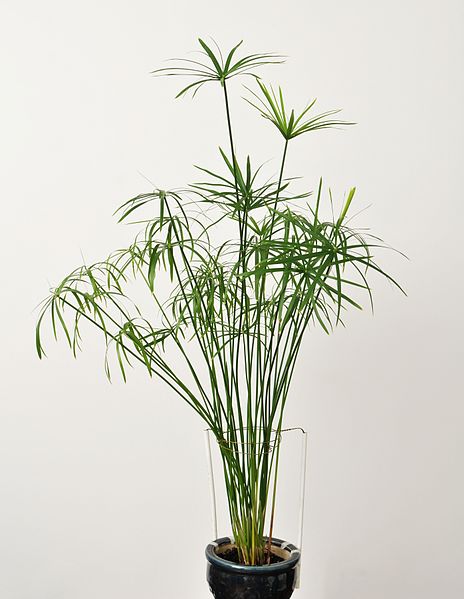
Image:HorsePunchKid, CC BY-SA 3.0, via Wikimedia Commons
LET736 Umbrella Plant ( Cyperus Alternifolius )
Also called the Umbrella Palm or Umbrella Grass Plant, this unusual perennial prefers to be kept wet at all times. In fact, it can grow very well submerged in water. Flower spikes and slim leaves form "umbrellas" on top of dark green stems. The best flowering and growth results appear in full sun, but Umbrella Plants can tolerate some shade. Brown leaf tips will form on the Umbrella Palm tree if it is allowed to dry out. Tidy the plant by removing broken or dead stems.
Cyperus Alternifolius Umrella Plant does best in a tropical environment, but it quickly adapts to the home. You cannot over water this plant! It will thrive when its roots are kept continuously wet. To ensure that the plant does not dry out, it is best to put the pot inside a second larger pot that has water in it, or grow Umbrella Plant in an aquarium or swamp type environment. Umbrella Grass Plant is well-suited as an ornamental water plant.
How To Grow Umbrella Plant: Sow Umbrella Plant seeds indoors. Pre-moisten peaty starter mix. Sow the Umbrella Palm seed on the surface, lightly cover. Keep the flower seeds continuously moist until germination. Keep the flower seed shielded from direct sunlight. Umbrella Plant will readily self-sow.
Cyperus Alternifolius Umrella Plant does best in a tropical environment, but it quickly adapts to the home. You cannot over water this plant! It will thrive when its roots are kept continuously wet. To ensure that the plant does not dry out, it is best to put the pot inside a second larger pot that has water in it, or grow Umbrella Plant in an aquarium or swamp type environment. Umbrella Grass Plant is well-suited as an ornamental water plant.
How To Grow Umbrella Plant: Sow Umbrella Plant seeds indoors. Pre-moisten peaty starter mix. Sow the Umbrella Palm seed on the surface, lightly cover. Keep the flower seeds continuously moist until germination. Keep the flower seed shielded from direct sunlight. Umbrella Plant will readily self-sow.
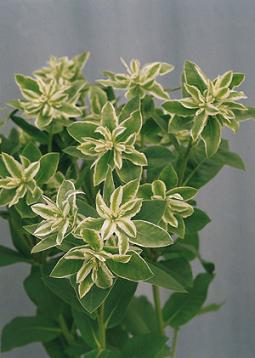
3295 Kilimanjaro ( Euphorbia marginata )
Pure white bracts, variegated foliage, strong stems, flowers under long days, early, for garden or cut. An excellent annual variegated foliage plant for borders, meadows and cutting gardens.
Grow as an annual plant, reaches 48" tall.
Grow as an annual plant, reaches 48" tall.
Seedman Cutflower Info:
Handling: Dip stem ends into hot to boiling water, then cut 1/2" from stem. The dipping prevents the flow of milk that will block the water vessels.
Vaselife: 8-12 days
Remarks: Sensitive to temperatures below 60 F. Do not keep around ripe fruit. Avoid contact of the milk with eyes.
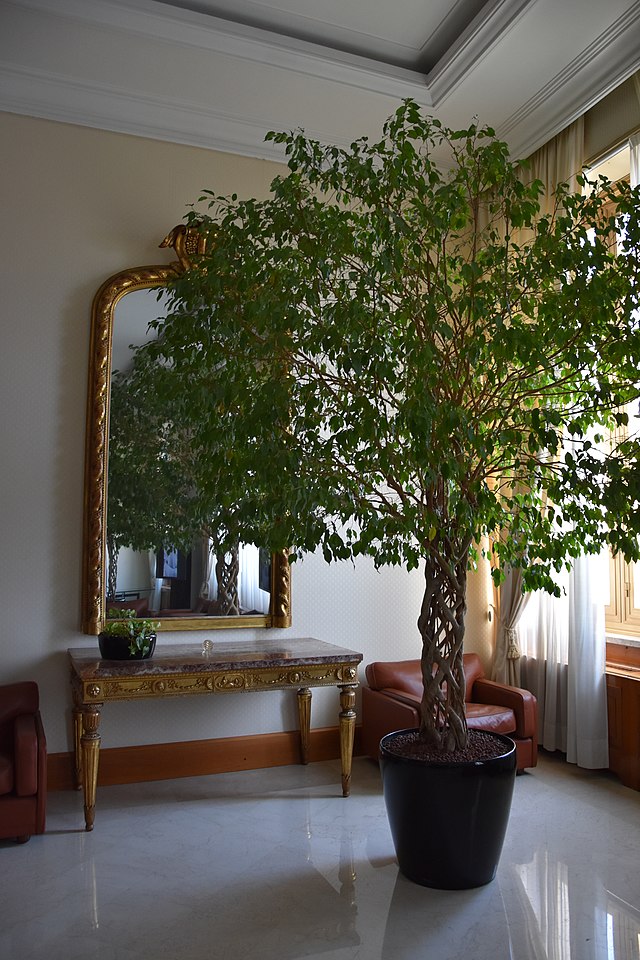
Image:Phyrexian, CC BY-SA 4.0, via Wikimedia Commons
D4509 Weeping Ficus ( Ficus benjamina )
One of the most recognizable house plants grown today. Very economical and easy to grow from seed and easy to care for. A fast growing plant that can become a centerpiece. It is a bit fussy about needing bright, diffused light ( like next to a bright window, but not in direct sunlight ). Also, do not overwater, only water when top of soil is dry.
Many people know the Weeping ficus as a common office plant, because it is very low-maintenance and has air-purifying effects. Most plants improve air quality to some degree. The F. benjamina is particularly good at filtering formaldehyde, xylene and toluene.
Many people know the Weeping ficus as a common office plant, because it is very low-maintenance and has air-purifying effects. Most plants improve air quality to some degree. The F. benjamina is particularly good at filtering formaldehyde, xylene and toluene.
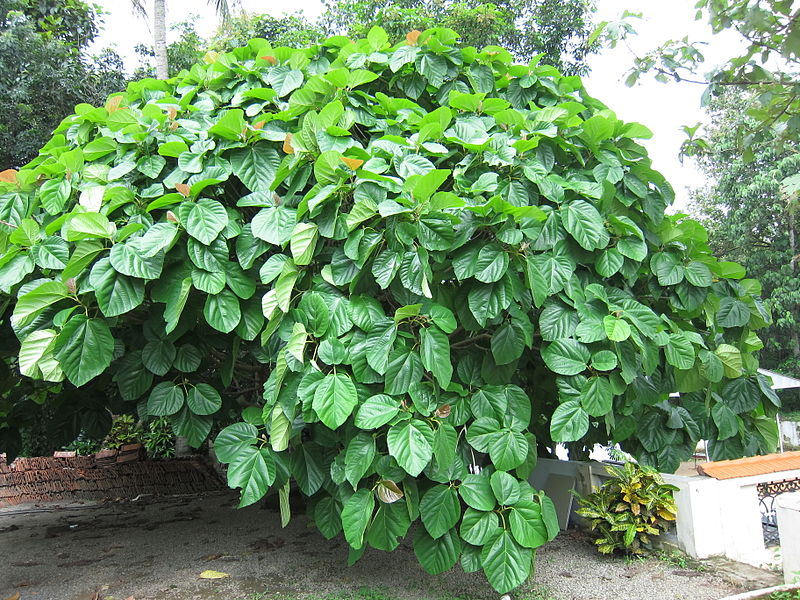
Image: കാക്കര [CC BY-SA 3.0], from Wikimedia Commons
D9916 Elephant Ear Fig ( Ficus auriculata )
A beautiful fig tree with very large oval leaves to 15". The leaves are bright red when they are developing and
exceptionally attractive - the decorative 2 1/2" fruits develop in clusters ( not edible ). This fast growing tree grows to 25' and develop a spreading canopy of 25' but can be kept pruned to a much smaller height.
Makes a sensational indoor specimen. seeds. Cold hardy to 25-30 degrees.
Makes a sensational indoor specimen. seeds. Cold hardy to 25-30 degrees.
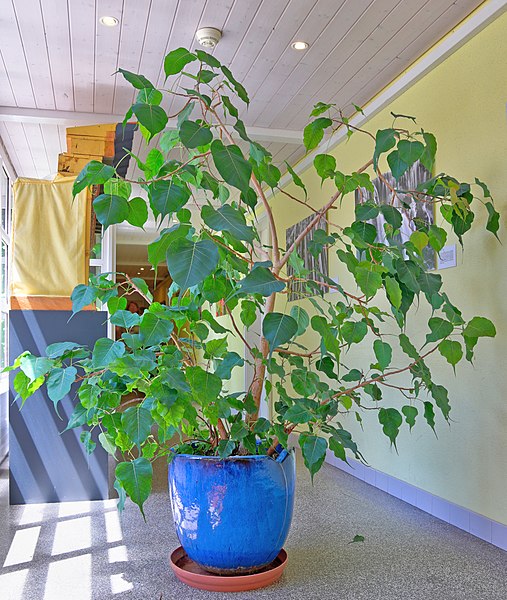
Image: Superikonoskop [CC BY-SA 4.0], via Wikimedia Commons
D4513 Peepful Fig ( Ficus religiosa )
Although it reaches great size outside in warm climates, this makes a wonderful houseplant for many years when grown from seed.
The famous Bodhi tree under which Buddha achieved enlightenment was a Ficus religiosa. In their native habitats, ficus is often seen as a landscape tree with hanging and buttressed roots and a magnificent crown. In the home, ficus is a beautiful specimen plant that can provide many years of lush foliage.
Ficus religiosa, commonly called bo tree, Bodhi tree, peepul and sacred fig, is native to Southeast Asia, southwest China, India and the Himalayan foothills. It is a large broadleaf evergreen tree with wide-spreading branching that grows to 60-100’ tall.
Winter hardy to USDA Zones 10-12 where it grows well in average, moist, well-drained soils in full sun. As a container plant, it is best grown in a soil-based potting mix. Site indoors in bright indirect light or in part shade with protection from afternoon sun. Water regularly during the growing season. Avoid overwatering. Reduce watering from fall to late winter.
Ficus religiosa, commonly called bo tree, Bodhi tree, peepul and sacred fig, is native to Southeast Asia, southwest China, India and the Himalayan foothills. It is a large broadleaf evergreen tree with wide-spreading branching that grows to 60-100’ tall.
Winter hardy to USDA Zones 10-12 where it grows well in average, moist, well-drained soils in full sun. As a container plant, it is best grown in a soil-based potting mix. Site indoors in bright indirect light or in part shade with protection from afternoon sun. Water regularly during the growing season. Avoid overwatering. Reduce watering from fall to late winter.
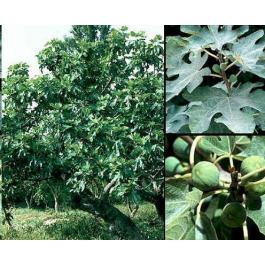
D9915 Common Fig ( Ficus carica )
The common fruiting fig also makes a nice houseplant! Ficus belongs to the Mulberry Family. The Common Fig is native to the eastern Mediterranean and western Asia region where it grows wild and has been in cultivation for centuries. The cultivated Fig forms a shrub or low-spreading tree.
The fig is a picturesque tropical looking tree or shrub with a dramatic spreading habit. The breadth is often wider than the height of 15 to 30 ft (4.6-9 m) with equal spread. This deciduous, low-branching tree is usually single trunked, with pale, silvery gray smooth bark. In colder regions, figs are grown as bushes with multiple stems and branches close to the ground that are laid down and buried before winter. The Ficus makes an especially attractive specimen in the landscape. Plant one on an expanse of lawn, where it's graceful spreading shape and smooth twisting branches command attention in all seasons.
The alternate, long petioled, dark green leaves are broad-ovate to nearly orbicular in outline and may become 20cm(10 in) long and 10-20 cm (4-10 in) wide with 3-5 lobes. The upper surface is thick and ribbed while the underneath is finely haired .The leaves texture is rough and they can irritate skin.
The Genus Ficus is unique for bearing its flowers inside a nearly closed receptacle, or branch, which ripens into a fleshy fruit called a fig. The small flowers are produced twice in the season. The first ones (the breba crop) are produced near the ends of the shoots of the preceding flush of growth, whereas the second crop (the main crop) is produced in the axils of the leaves on the new growth.
The mature fruit is pear shaped and variable in size and range in color from a greenish-yellow to purple. The edible fruit is a hollow succulent receptacle with many ovaries on the inner surface, which may or may not produce seeds, depending on the variety.
Figs usually begin bearing fruit within two years and may bear twice per year. Figs grow nicely and will bear fruit when grown in containers where they can be artfully pruned to create a living sculpture to decorate deck or patio. This is convenient for two reasons: cold climate growers can move their figs indoors in winter and the plants can be removed from the patio when the fruit begins to (over)ripen. The edible fruit are extremely attractive to birds.
Hardy for zones 7-10. Note that with winter protection, it can be grown as far north as Zone 5. The Ficus Carica likes reflected sun, full sun, or part shade. Fig trees are tolerant of poorly drained soils and grow well in relatively infertile soils. When fully dormant, fig trees can tolerate temperatures as low as 10 to 15°F (-9°C). Even if frozen, figs often will restart from the roots and produce a crop the following summer. They are drought tolerant, once established. Figs responds well to pruning and can be espaliered or pruned heavily in the dormant season for size control and to increase the main crop. Water the tree every month or two while it is growing, and once or twice per year when fully grown. They grow much better with a monthly fertilizing program and deep watering twice a month in summer.
The fig is a picturesque tropical looking tree or shrub with a dramatic spreading habit. The breadth is often wider than the height of 15 to 30 ft (4.6-9 m) with equal spread. This deciduous, low-branching tree is usually single trunked, with pale, silvery gray smooth bark. In colder regions, figs are grown as bushes with multiple stems and branches close to the ground that are laid down and buried before winter. The Ficus makes an especially attractive specimen in the landscape. Plant one on an expanse of lawn, where it's graceful spreading shape and smooth twisting branches command attention in all seasons.
The alternate, long petioled, dark green leaves are broad-ovate to nearly orbicular in outline and may become 20cm(10 in) long and 10-20 cm (4-10 in) wide with 3-5 lobes. The upper surface is thick and ribbed while the underneath is finely haired .The leaves texture is rough and they can irritate skin.
The Genus Ficus is unique for bearing its flowers inside a nearly closed receptacle, or branch, which ripens into a fleshy fruit called a fig. The small flowers are produced twice in the season. The first ones (the breba crop) are produced near the ends of the shoots of the preceding flush of growth, whereas the second crop (the main crop) is produced in the axils of the leaves on the new growth.
The mature fruit is pear shaped and variable in size and range in color from a greenish-yellow to purple. The edible fruit is a hollow succulent receptacle with many ovaries on the inner surface, which may or may not produce seeds, depending on the variety.
Figs usually begin bearing fruit within two years and may bear twice per year. Figs grow nicely and will bear fruit when grown in containers where they can be artfully pruned to create a living sculpture to decorate deck or patio. This is convenient for two reasons: cold climate growers can move their figs indoors in winter and the plants can be removed from the patio when the fruit begins to (over)ripen. The edible fruit are extremely attractive to birds.
Hardy for zones 7-10. Note that with winter protection, it can be grown as far north as Zone 5. The Ficus Carica likes reflected sun, full sun, or part shade. Fig trees are tolerant of poorly drained soils and grow well in relatively infertile soils. When fully dormant, fig trees can tolerate temperatures as low as 10 to 15°F (-9°C). Even if frozen, figs often will restart from the roots and produce a crop the following summer. They are drought tolerant, once established. Figs responds well to pruning and can be espaliered or pruned heavily in the dormant season for size control and to increase the main crop. Water the tree every month or two while it is growing, and once or twice per year when fully grown. They grow much better with a monthly fertilizing program and deep watering twice a month in summer.
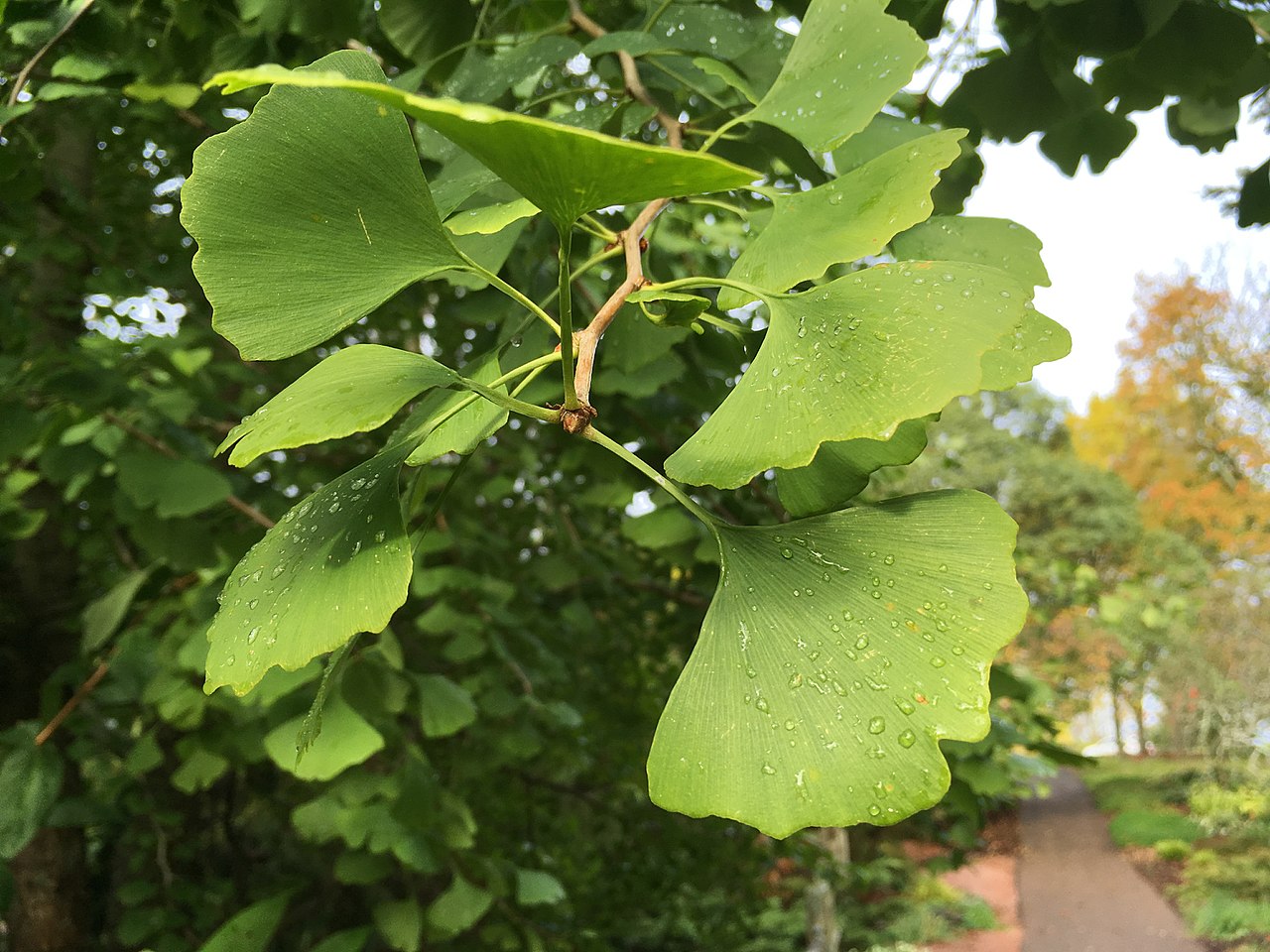
Image: By YSmomilomii [CC BY-SA 4.0], from Wikimedia Commons
D2977 Gingko Biloba
A most unique tree with colorful, beautiful foliage. A great ornamental tree famous for its interesting shape and vibrant foliage, it stands out with a tall, rounded form and delicately-crafted leaves.
Unique, fan-shaped leaves turn a stunning yellow color in the fall. It can tolerate many urban conditions including heat, air pollution, salt, and confined spaces. And it establishes easily. And it thrives just about anywhere in the United States. It's especially perfect for urban areas since it won't be bothered by smog and other pollution.
The Ginkgo tree is a living fossil, with the earliest leaf fossils dating from 270 million years ago. It was rediscovered in 1691 in China and was brought to this country in the late 1700s. The seeds and leaves have been (and are still today) used in medicine throughout the world.
An interesting fact about the ginkgo,there are only five living groups of seed plants, and ginkgo is one of them. And ginkgo is the only one that consists of just one species.
Excellent selection for a variety of uses, including lawn tree, street tree or shade tree. Also effective in city parks or near commercial buildings. A mature tree can grow to 80 feet tall with a 30-40 feet wide canopy. Its nuts are regarded as a delicacy in the Orient. It is the source of the famous herbal supplement. A favorite bonsai specimen. Well suited for zones 3-8.
For more info on the Ginko, please visit the Gingko Page
Unique, fan-shaped leaves turn a stunning yellow color in the fall. It can tolerate many urban conditions including heat, air pollution, salt, and confined spaces. And it establishes easily. And it thrives just about anywhere in the United States. It's especially perfect for urban areas since it won't be bothered by smog and other pollution.
The Ginkgo tree is a living fossil, with the earliest leaf fossils dating from 270 million years ago. It was rediscovered in 1691 in China and was brought to this country in the late 1700s. The seeds and leaves have been (and are still today) used in medicine throughout the world.
An interesting fact about the ginkgo,there are only five living groups of seed plants, and ginkgo is one of them. And ginkgo is the only one that consists of just one species.
Excellent selection for a variety of uses, including lawn tree, street tree or shade tree. Also effective in city parks or near commercial buildings. A mature tree can grow to 80 feet tall with a 30-40 feet wide canopy. Its nuts are regarded as a delicacy in the Orient. It is the source of the famous herbal supplement. A favorite bonsai specimen. Well suited for zones 3-8.
For more info on the Ginko, please visit the Gingko Page
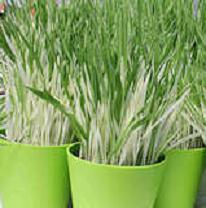
3293 Variegated Cat Grass ( Hordeum vulgare )
Green and white striped, wide leaf, scented, cats love it, fast growing, for container or garden. A decorative plant even if you do not have cats.
Hardy outside to zone 5, grows about 12" tall.
Hardy outside to zone 5, grows about 12" tall.
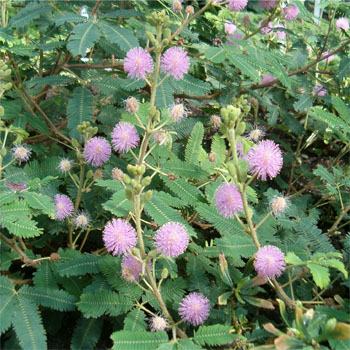
D5111 Sensitive Plant ( Mimosa pudica )
Children love this plant! Sensitive Plant is a fascinating plant with a remarkable response to touch. When the leaves’ hairs are stimulated by touch or other forms of stimulation, they trigger an electrical impulse that causes the leaflets to fold inwards! After a few moments, the leaves open back up, touching the plant leafs numerous times to watch it close and open does no harm to the plant. Aside from its unique leaf movement, the sensitive plant is also prized for its delicate, fern-like foliage and attractive light purple flowers. While Mimosa Sensitive Plant can be grown outdoors, as it has the potential to escape and naturalize easily; we prefer to grow it as a houseplant.
Mimosa pudica has a wide range of health benefits for issues like parasites, depression, anxiety, insomnia, and diarrhea.
Click here for a good Youtube video on the plant.
Mimosa pudica has a wide range of health benefits for issues like parasites, depression, anxiety, insomnia, and diarrhea.
Click here for a good Youtube video on the plant.

D1109 Bird of Paradise ( Strelitzia reginae )
One of the most attractive of all tropical plants.
The Bird of Paradise is delightfully easy to care for and enjoys warm, balmy days year round. The stunning flowers of this unique plant make it popular in gardens around the globe.
Flowering occurs multiple times a year if the plant is well taken care of. It is a long lived plant, and takes up to three years to begin producing flowers. Once it begins flowering, however, this plant will provide you with years of delight.
Once flowering begins in early spring, each plant will produce up to six flowers in succession, with each flower being long-lived. Blooming can be almost continuous from early spring into early fall, provided the plant is cared for. This plant requires little encouragement to bloom, happy with enough light and water for its needs.
It comes from S Africa. The flowers take shape of a most peculiar form, resembling birds in flight. Grows to a height of about 3 feet in containers, but can reach 6 feet outside.
They can tolerate temperatures as low as 55 degrees, but prefer to remain in the 70-90 degree range.
The Bird of Paradise is delightfully easy to care for and enjoys warm, balmy days year round. The stunning flowers of this unique plant make it popular in gardens around the globe.
Flowering occurs multiple times a year if the plant is well taken care of. It is a long lived plant, and takes up to three years to begin producing flowers. Once it begins flowering, however, this plant will provide you with years of delight.
Once flowering begins in early spring, each plant will produce up to six flowers in succession, with each flower being long-lived. Blooming can be almost continuous from early spring into early fall, provided the plant is cared for. This plant requires little encouragement to bloom, happy with enough light and water for its needs.
It comes from S Africa. The flowers take shape of a most peculiar form, resembling birds in flight. Grows to a height of about 3 feet in containers, but can reach 6 feet outside.
They can tolerate temperatures as low as 55 degrees, but prefer to remain in the 70-90 degree range.
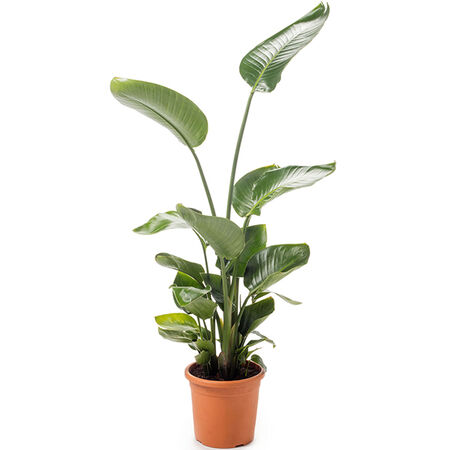
JB268 Giant White Bird of Paradise ( Strelitzia
nicolai )
Bird of paradise is a stunning tropical plant commonly grown as a houseplant throughout the country and a landscape plant in zones 9 and up. These are among the most popular houseplant and patio plants in use today.
This famous giant tropical plant is known for reaching 12 feet or more outdoors in height and bearing loads of brilliant white flowers.
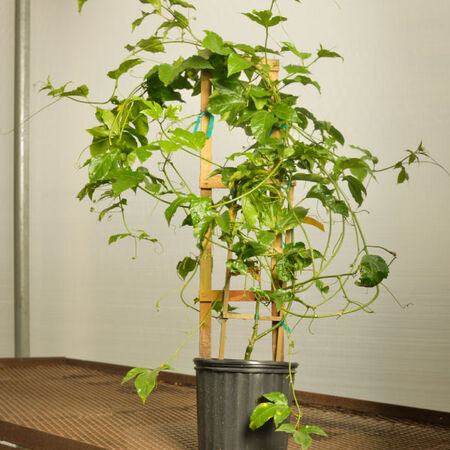
D8564 Passion Fruit ( Passiflora edulis )
A fun indoor plant that will need vine support. A fast growing vine, especially in the tropics, the passion fruit can grow over 20ft in a single year. This fern has tiny, oval-shaped leaves that give a soft evergreen appearance. This plant can be grown indoors as a hanging plant or as a guided climber. Also does a great job at purifying indoor air.
Ripe fruits are edible off the vine or incorporated into a variety of food products such as beverages, jellies, fruit salads and sherbets. This plant has many uses: as a screen, to attract butterflies and hummingbirds, and it looks great cascading down a wall. This vine, native to the Amazon, produces beautiful flowers and sweet-tart fruit. It was named by the Spanish missionaries in South America who saw the Passion (suffering) of Christ represented in its flowers.
Zones 9b and higer it is a perennial.
Ripe fruits are edible off the vine or incorporated into a variety of food products such as beverages, jellies, fruit salads and sherbets. This plant has many uses: as a screen, to attract butterflies and hummingbirds, and it looks great cascading down a wall. This vine, native to the Amazon, produces beautiful flowers and sweet-tart fruit. It was named by the Spanish missionaries in South America who saw the Passion (suffering) of Christ represented in its flowers.
Zones 9b and higer it is a perennial.
INTERESTING HOUSEPLANT LINKS
Get Set! This is a great site
with many helpful links, especially hydroponics links
Zone 10was established to offer the horticultural community of zone 10 an efficient means of disseminating product information and current availability.

